Sensitivity and response in plants:
Detection of change in environment and mechanism of response in plants :
Living organisms exist in a changing environment. Some changes are favourable and advantageous, while others are unfavourable or harmful. Sensitivity is the ability of organisms to detect change and respond to it.
Changes which are detected and lead to responses are referred to as stimuli. All living organisms respond to stimuli. Stimulus is a kind of energy.
Definition: Any physicochemical change of energy in the surrounding environment of an organism that can generate an impulse or response in the organism is called as stimulus.
The stimulus may be external like water, temperature, oxygen, air etc. Whereas internal stimulus; may be hormone, nutrient etc.
Any sort of change in direction or position found in living organisms is called movement. When movement is associated with change of place it is termed locomotion.
Read and Learn More Class 10 Science
Definition: The process by means of which the living organisms, spontaneously or due to the influence of stimuli, can move any part of their body is called movement.
In higher plants, movement is a common phenomenon. However, some exceptional plants like chlamydomonas, volvox can very slowly swim in water and are not fixed at a particular place.
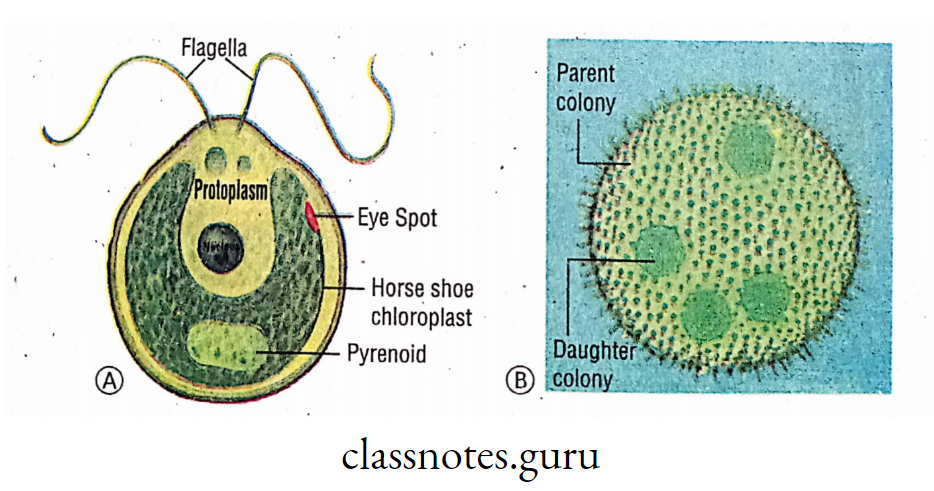
When the whole body of an organism is shifted from one place to other place, it is called locomotion. This is generally found in animals. However, Sponge, Coral, Ascidia etc. are fixed at substratum—they exhibit little movement but. no locomotion. These animals are called as sedentary or sessile animals.
Control and Co-ordination in Living Organisms: Class 10 Science Notes
Relation between movement and locomotion :
In fact, the basic relation between movement and locomotion is that movement of locomotory organs result into locomotion e.g. movement of wings in birds result into flight.
As most plants are anchored organisms, plant responses are less evident than those of animals. Rapid movements by plants are extremely rare. Generally, plant responses are slow growth movements or turgor movements.
Plant sensitivity and response in Mimosa and Desmodium: Both the plants are extremely sensitive. When the leaflets or Mimosa puriivC (touch-me-not/Lajjabati) is touched, they droop down—this is commonly known as seismonastic movement.
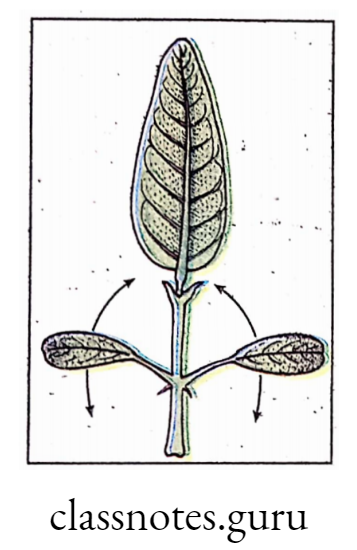
In fact,below the leaf stalk there is a swollen structure called pulvinus. In the pulvinus, there are highly sensitive motor cells. Touch causes vibration when water droplets ooze out of the pulvinus into intercellular spaces resulting into decrease in turgor pressure. So the leaflets droop down.
In Desmodium gyrans (Indian Telegraph plant), there is spontaneous movement of curvature caused by the reversible change in turgor pressure which is known as movement of/ variation.
Due to variation in turgor pressure the leaves move up and down rhythmically, as if the plant is dancing or sending out telegraph message. The leaves of the plant will “dance” only when there is light to absorb maximum solar energy for photosynthesis. In the evening, the leaves droop downwards
Question. How does a plant sense environmental changes ?
Like animals, plants sense changes in their surroundings and respond to them. Plants are able to detect and respond to light, gravity, changes in temperature, chemicals, moisture, infections, ; sound, touch etc.
Unlike animals, plants do not have nerves or muscles, so they can not move very fast. A plant usually responds to change by gradually altering its growth rate or direction of growth or turgor pressure.
Plants sensing direction of light : In the morning sunflower faces towards east and as the day progresses, it gradually -bends towards west.
Plants sensing duration of light and I temperature: Some plants bloom in summer (e.g. Mogra, Jasmine etc.) whereas some others bloom in winter (e.g. Dahlia; Chrysanthemum) which reflects that plants can respond to long day (LDP) and high temperature of summer or short day (SDP) and low temperature of winter.
Plants sensing contact with hard object: Some plants respond to contact (e.g. climbers like Pea plants, Passion flower) by curving their tendrils (thigmotropism).
Plants sensing magnetic field: Some plants can perceive magnetic fields using cryptochromes (a type of flavoproteins, sensitive to blue light).
Plants producing signalling molecules: Injured tomatoes can produce methyl-jasmonate having volatile odour. This chemical produces an alarm signal to alert the neighbouring plants who will produce chemicals to protect themselves.
Plants develop action potential: Plants can produce several proteins found in animal neuron like Acetylcholine esterase etc. Although plant body does not contain any neuron, they can be electrically excitable with action potential to environmental stimuli.
Electrical responses can cause the synthesis of numerous organic molecules.
Plants produce various biochemir.ais in response to stimuli: A plant’s reactive behaviour is mediated by phytochromes, kinins, hormones, antibiotics etc.
Plants can fight off pests: Plants have many strategies to fight off pests. For example, they can produce different toxins (phytoalexins) against pests after pest attack.
Photo-sensitivity in plants: Many plant organs contain photosensitive compounds (photo tropins, cryptochromes, phytochromes)—each of which reacts very specifically to certain
wavelength of light.
These light sensors tell the plant if it is day or night, how long the day is, how much light is available and from where the light comes. Shoots grow towards light (phototropism), root grow away from light (skototropism).
Plants sensing quality of light: Plants are also able to sense the quality of light and respond appropriately. For example, in low light conditions, plants produce more photosynthetic pigments. If the light is very bright of if the levels of harmful UV increase, plants produce more protective pigments that act as sunscreens.
Plants sensing gravitational pull: In the root cap, there is a special subset of cells, called statocytes which contain some specialized arnyloplast that are involved in perception of gravity by plants causing geotropism/gravitropism.
Hypersensitivity in Mimosa:-Pulvinus is a group of cells at the base of leaf or leaflet in certain plants, that rapidly loose water, brings about changes in the position of the leaves (eg. Minosa pudica).
Plant,sensing mechanical stimulus: Motor cell is a type of plant cell that enables the movement of plant parts, such as closing and opening of leaflets in response to intensity of touch or any other mechanical stimulus, or rapid closure of leaf in a carnivorous plant.
Motor cells accumulate 1C1- that causes osmotic uptake of water into the cell, making the cell turgid. Conversely, they can pump K+ out of the cell, which causes water to leave the cell and cell shrinks.
Hypersensitivity of carnivorous plants: Hair cells present on the surface of the leaves of Drosera, Dionaea etc. are sensitive to touch stimulus of insects and others and perform stepwise reactions to trap the insect.
Stimulus and response in plants: Transmission of stimulus in plants is a slow process (since they have no neurons). The time taken by the stimulus to reach to the point of response is called transmission time.
The interval between application of stimulus and production of visible response is called latent period.
Contribution of Acharya Jagadish Chandra Bose :
Sir Jagadish Chandra Bose, first modern Indian Scientist,physicist, discovered radio and microwave optics, invented the instrument Crescograph. He has lot of contribution in the field of Biophysics.

NCERT Class 10 Science Notes: Control and Co-ordination
Crescograph capable of magnifying the motion of plant tissues to about 10,000 times of their actual size. His significant discoveries were-

- There is intimate relation between electric potential and turgor pressure of a plant cell.
- Stimuli like chilling, heating, cutting, touching result into response in plants;
- Sensitivity test on Mimosa and Desmodium;
- Action of microwaves on plant tissues;
- Scientific parallelism between plant and animal tissues and so on. He concluded that plants can feel pain, understand affection.
Plant movement:
Absence of locomotory organs in majority of plants :
Most of the plants are stationary. However Chiamydomonas, Volvox, etc. show locomotion. Higher plants can position of their organs.
Types of movements in plants: Three major types of movements shown by plants are—
- Tactic movement,
- Tropic movement and
- Nastic movement.
Tactic movement/Taxism: Definition: It is the induced movement of locomotion where a plant can move freely or swim from one place to another by the influence of light, temperature, chemicals etc.

Phototactic movement/Phototaxism: The induced growth movement of locomotion in plants which is influenced by light is called phototaxism. eg. Swimming of chiamydomonas, Volvox towards light by flagellar movement.
Tropic movement/Tropism: Definition: It is the induced movement of curvature of any plant part or organ, which is influenced by direction of external stimulus either towards or away. ‘
Characteristics of tropic movement :
- It is the induced movement of curvature,
- It is influenced by direction of stimulus.
- Tropic movement occurs due to growth,
- It occurs in immatured growing region of plant body.
- Tropism is influenced by auxin hormone,
- It may be towards the stimulus (+ ve) or away from stimulus (- ve).
Types of tropic movement :
Phototropic movement/ phototropism/ Heliotropism: It is the induced growth movement of curvature of plant organ in response to the direction of light.
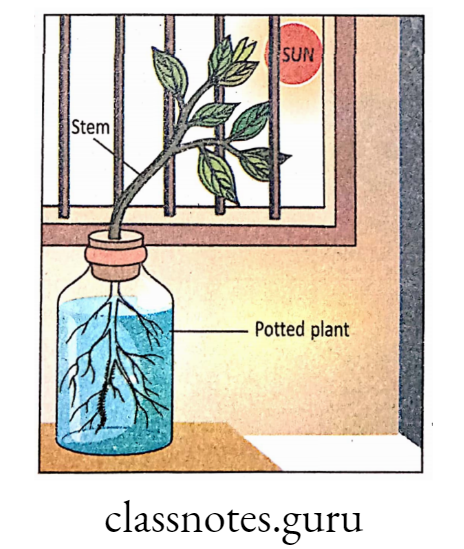
Examples :
- Shoots growing towards the source of light are positively phototropic,
- Roots growing away from light is negatively phototropic.
- Leaves remaining at right angles to the source of light are transversely phototropic.
Evidence— A potted plant kept near open window bends towards the source of light.
Experiment on phototropism :
- Materials required— Potted seedling, table.
- Procedure— The potted seedling is kept near the open window through which adequate sun-light fall on the seedling.
- Observation— After some days we notice that the stem moves towards the source of light i.e., towards the open window.
- Inference— We can thus say that the stem, moving towards the direction of the external stimulus i.e., light, is positively phototropic or in other words, positively heliotropic.
The leaves being in a transverse position towards the external stimulus is transversely phototropic.
Geotropic movement/Geotropism/Gravitropism: It is the induced growth movement of curvature of plant organs in response to the direction of force of gravity.
Examples: Root moves towards the force of gravity and is hence positively geotropic and shoot grows in the opposite direction and is hence negatively geotropic. Lateral roots and branches grow at right angle to the force of gravity and are called transversely geotropic or diageotropic.
Control and Co-ordination in Living Organisms: Nervous System and Hormones
Experiment on geotropism :
- Materials required— Few germinating seeds, a moist substance (saw dust).
- Procedure— The germinating seeds are placed in a horizontal position over the moist substance (wet saw dust) and kept in a dark chamber in order to avoid the influence of light.
- Observation— After some days it will be seen that the tip of the radicle bends downwards showing positive geotropism of root, and the plumule moves in a direction vertically upwards showing negative geotropism of stem.
- Inference— Stem bending in the direction away from the external stimulus (gravitational pull) shows negative geotropism, whereas, the root shows positive geotropism by moving towards the external stimulus.
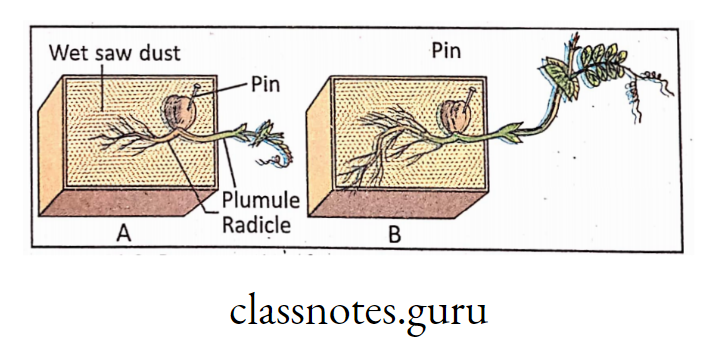
Hydrotropic movement/Hydrotropism: It is the induced growth movement of curvature of plant organs in response to the source of water.
Examples: The roots grow generally towards the source of water and shoot moves away from it. The former is positively hydrotropic, while the latter is said to be negatively hydrotropic.

Experiment on hydrotropism: This experiment has also been shown in the figure. The roots of seedlings are positively hydrotropic which was demonstrated by keeping them on moist hanging sieve container containing moist saw dust.
Observation: It has been observed that, the roots after passing through the holes of sieve, bend and spread on the moist outer surface of the container in search of water instead of going downwards.
Mastic movement/Mastism): Definition: It is the induced movement of curvature of any plant part or organ, which is influenced by intensity of external stimulus (but not by direction).
Characteristics of nastic movement :
- This is induced movement of curvature.
- This is influenced by intensity of stimulus.
- Nastic movement occurs due to variation in turgor pressure.
- It occurs in matured parts of plant body.
- It is mostly positive (+ ve) movement.
Types of nastic movement :
Photonasty—The nastic movement induced by the change in light intensity is called photonasty.
Examples—
- Water lily, lotus, sunflower, poppy open at sunrise and close at sunset, are positively photonastic.
- Flowers of night queen (Cestrum nocturnum) opening at night, are called negatively photonastic.
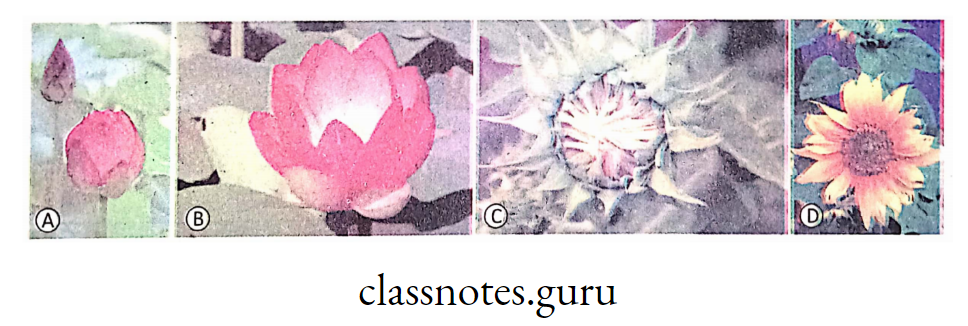
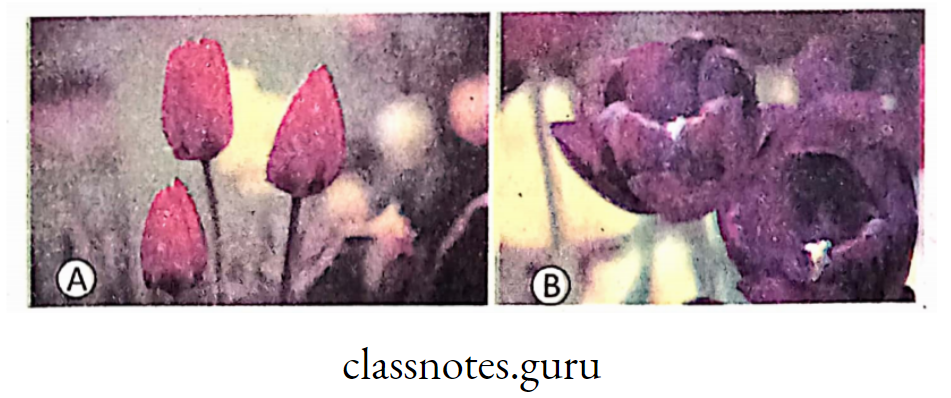
Thermonasty—The nastic movement induced by the variation in degree of temperature is called thermonasty.
Examples— Flowers like Tulip, Crocus, open at higher temperature but close with fall of temperature.
Chemonasty—The nastic movement induced by change in intensity’ of certain chemical substance is called chemonasty.
Examples— Movement of tendril away curving of tentacles of the insectivorous plantresponse to soluble proteins when placed atcentre of the leaf.
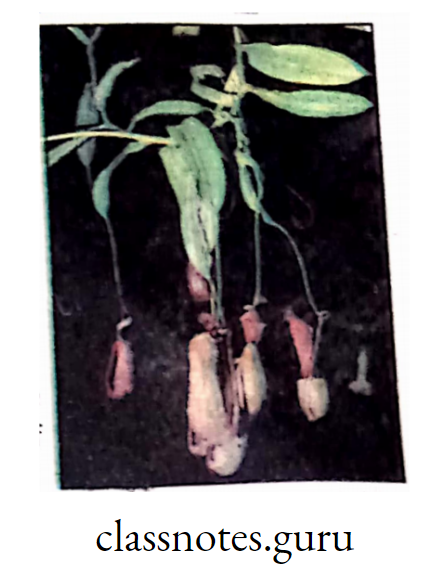
Seismonasty—The nastic movement in response to the intensity of mechanical stimuli such as contact with foreign body, pressure, shock, shaking, etc. is called seismonasty. The
extent of seismonastic movement depends upon the intensity of stimulus, the vigour and age of the plant.

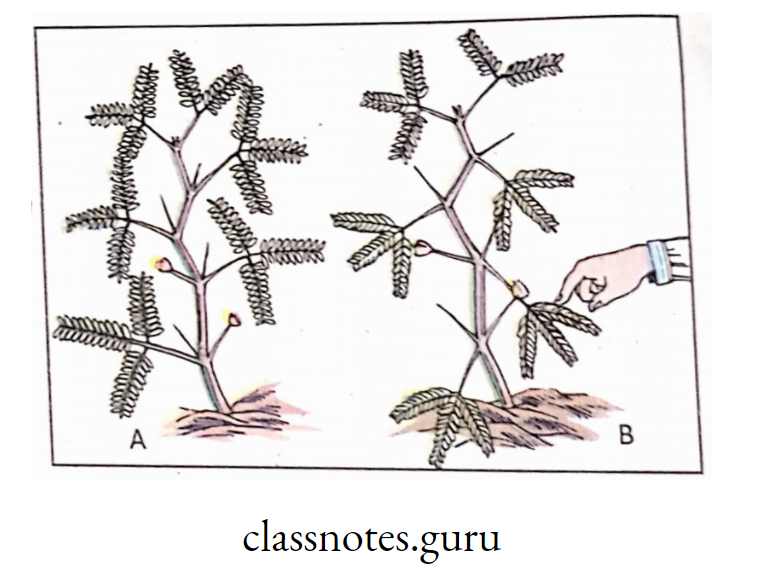
Examples— Leaflets of Mimosa pudica when touched droop down. This movement is based on changes in turgor pressure in the sensitive motor cells of pulvinus, the swollen basal region at leaf base containing sensitive cells.
Class 10 Science: Control and Co-ordination Notes
Comparison among Tactic, Tropic and Nastic movement
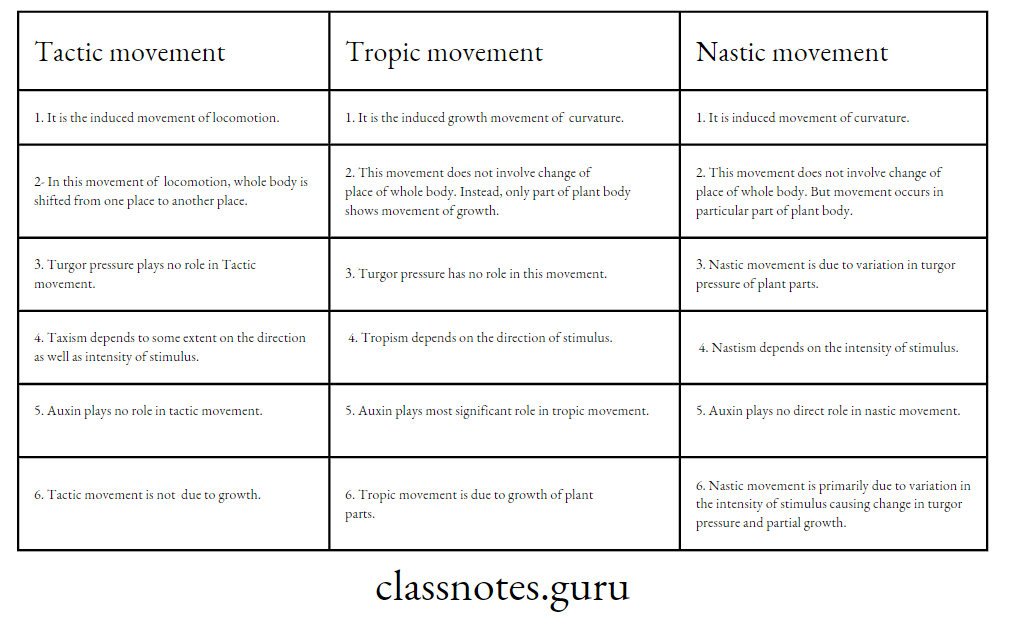
Response and chemical coordination in plants—Hormones
The normal growth of plant body does not depend entirely upon the environmental conditions, but the growth of plant body is also influenced by the chemical substances produced in the plant body.
These growth promoting organic chemical substances are called plant hormones or Phytohormones or “Growth Promoting Substances” (GPS) or “Plant Growth Regulators” (PGR). The term phytohormone was coined by Thimann.
Definition: Phytohormone (plant hormone) Is the organic chemical substance produced in minute amounts naturally in higher plants, controlling growth and other physiological functions on target organs either locally or at a site remote from its place of production.
Need for regulation of different activities of the plant body and the role of hormones :
Phytohormone can regulate various general activities of the plant body as follows—
- Plant hormones are responsible for sensitivity and response in plants.
- Plant hormones primarily control apical and lateral growth, flowering in plant, blossoming of bud into flower, germination by breaking the dormancy of seed, prevention of shedding of immatured leaves, fruits, seeds etc.
- Phytohormone plays a significant role in tropic movement, particularly phototropism and geotropism.
Discovery of plant hormone :
Charles Darwin and his son Francis Darwin (1880) first postulated presence of some ‘ exciting organic chemical responsible for bending curvature (tropic movement) of seedling.
Later on many scientists like Sachs (1889), Boysen-Jensen (1913), Paal (1919), Went (1932) made different experiments to confirm the presence of “exciting organic chemical” as phytohormone. First plant hormone discovered was auxin.
Characteristics of plant hormones :
- Plant hormones occur in extremely low concentration.
- Source— Plants lack definite glands that produce and secrete hormones. Almost all meristematic tissue can produce hormone.
- Plants usesimple chemicals as hormones, which diffuse more easily through the plant tissues.
- Mode of transport— Plant hormones may act locally when slow diffusion can take place bycytoplasmic streaming.
- Phytohormones may be also transported to distant target organ through xylem (ascent of sap) along with plant sap or through phloem (translocation) along with prepared food materials.
- Fate of hormones in plants— Plant hormones can not be stored in the plant cells—so they are destroyed after their function or reaction.
- General function of plant hormone— Plant hormones help in growth of different parts of the plant body (like root, stem, leaf, flower, fruits and seeds), development, cell division, bud formation, seed germination, fruit formation, prevention of premature leaf fall and fruit fall, and also control the different physiological function of the plant body.
- Types of plant hormone— In general> there are five . major classes of phytohormones— Abscisic acid (ABA), Auxin, Gibberellin, Cytokinin and Ethylene.
- Chemical nature of phytohormone— Most of the plant hormones are acidic in nature except cytokinin which is basic in nature.
- Generally plant hormones are nitrogenous compound (exception gibberellin which is non nitrogenous plant hormones}.
Types of plant hormones :
Those hormones which are synthesised within’ the plant body are called natural hormones, e.g., Auxins or Indole acetic acid (IAA) —is nitrogenous hormone, Gibberellins or Gibberellic acid (GA)—is non-nitrogenous hormone, Cytokinins—is . nitrogenous hormone, etc.
Some other important plant hormones: 1
- ABA (Abscisic acid)—It slows down plant growth, plays role in abscission of plant leaves in winter. Abscisic acid is also known as stress hormone in plant.
- Ethylene—It acts as plant hormone. It helps in ripening of fruits, opening of flowers etc. It is gaseous plant hormone.
- Florigen—It is hypothetical plant hormone responsible for flowering in plants (blooming of bud into flower). It is produced in the leaves and acts in the apical meristem of shoot.
Origin, chemical constituents and role of Auxin, Gibberellin and Cytokinin.
Auxin Definition: The plant hormone containing indole group, produced mostly by apical meristem, and controls the growth of shoot, root and other growing parts of plant is called auxin.
Nervous System and Hormonal Control: Class 10 Science Explanation
Characteristics of auxin :
- It is the most important plant hormone.
- It is acidic in nature.
- IAA (Indole Acetic Acid) is nitrogenous compound.
- It contains indole chemical group.
- It is primarily responsible for apical dominance.
Origin: Auxin is almost universally present in all plants. It is synthesized at the growing parts of higher plant organs like apex of the stem, young expanding leaves, fruits, flowers, seeds etc.
Auxin is synthesized in the living plant cells through a series of steps from amino acid tryptophan.
Auxin is generally transported from apex to base (basipetal).
Chemical constituents :
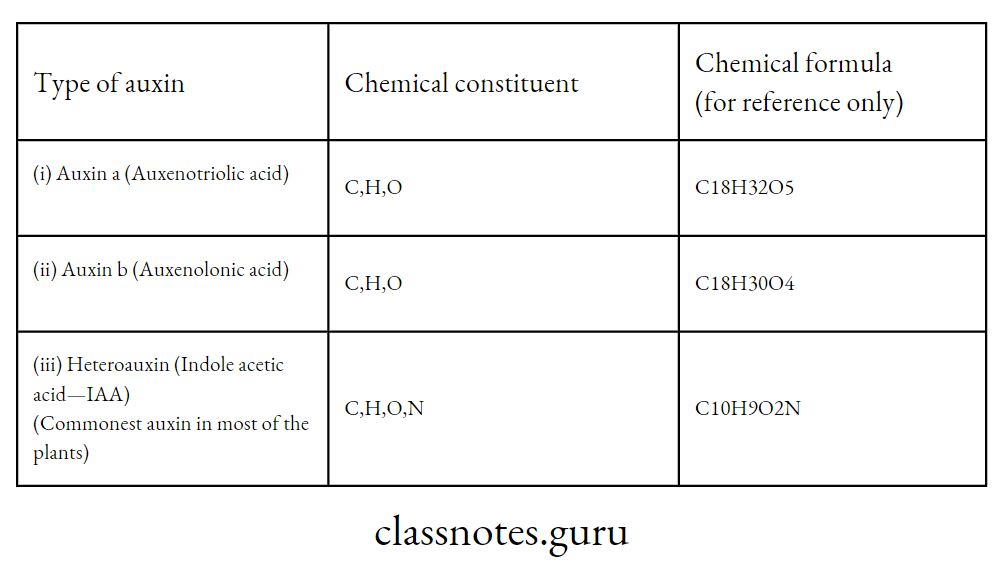
Role of auxin (Function) :
Apical dominance—It is the phenomenon by means of which the growth of the apical bud inhibits the development of lateral buds. When the apical bud is removed, then it stimulates the formation of lateral buds.

Cell division—Auxin takes part in nuclear division and thereby increases the rate of cell division causing increase in cell number (Hyperplasia).
Cell elongation enlargement— Auxin helps to increase the size and volume of the cells (Hypertrophy).
Root growth—In case of horizontal seedling, more auxin is accumulated on the lower (darker) side than to its upper side (illuminated part). This unequal distribution of auxin causes unequal growth rate—thus producing a curvature.
Plant roots grow well at a lower concentration of. auxin (whereas stem grows well at a higher concentration).
High concentration of auxin causes higher growth in stem whereas in root high concentration of auxin retards growth rate. Thus upper part of radicle grows faster than that of lower part.
Hence the root bends downward to soilresulting into positive geotropism.
Fruit growth—After fertilization, due to chemical changes, ovule develops into seed and ovary into fruit. The process of formation of seedless fruits without pollination and fertilization is called parthenocarpy.
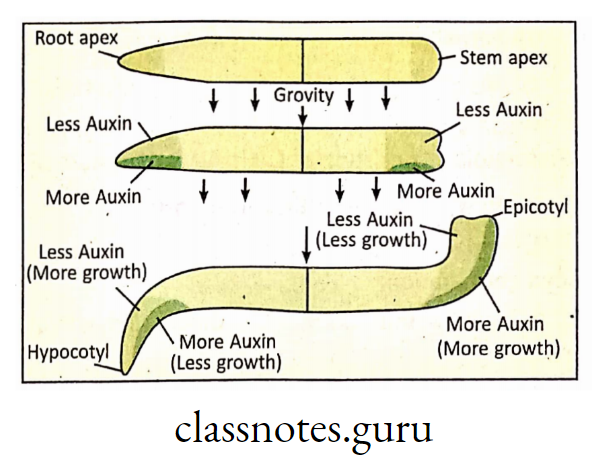
Now-a-days it is possible to stimulate fruit development in flowers without pollination simply by the application of auxin (IAA) to the flower. Due to its effect seedless fruits are produced e.g. Banana, Papaya, Grapes, Tomato, etc.
Control of tropic movement (Tropism)—Tropism is a movement in plant where the direction of root and shoot growth alters according to the direction of stimulus. This tropic movement is influenced by auxin hormone.
Auxin is synthesized in greater quantity towards shady part of plant than bright illuminated part. In stem higher concentration, of auxin accelerates growth rate. So stem is positively phototropic.
Gibberellins :
Definition: The non-nitrogenous organic acid having terpenoid group which act as growth promoting substances in plants are called Gibberellins. So, Gibberellin is non-nitrogenous acidic plant hormone.

Characteristics of gibberellin :
- It is an important plant hormone.
- It is acidic plant hormone.
- Chemically, it is nonnitrogenous compound.
- It contains terpenoid chemical group.
- It primarily helps in germination of seed.
Japanese plant pathologist Kurosawa (1926) first discovered this plant growth substance in Gibberella fujikuroi fungus that caused extensive growth in infected plants. The name Gibberellin was introduced by Yabuta (1935).
Nearly 50 types of gibberellin have been discovered so far (like
GA1 GA2 etc.) of which GA3 is very important.
Origin: Gibberellins are naturally synthesized in the maturing seeds, germinating seedlings, growing tissues of expanding cotyledons, growing leaf, apical buds, root tips etc.
Glbbmollin Is synthesized from Acetate.
Gilhberellin Is, transported In all direction from their site of formation.
Chemical constituents: Glbberellins are colourless acids, non-nitrogenous diterpenoids, consisting of C, H and 0. [Formula of
GA3 is C 19H22O6.]
Role of Glbberellin (Function) :
- Breaks seed dormancy—Glbberellin removes the dormancy of seed and influences seed germination.
- Breaks, bud dormancy—Glbberellin stimulates growth of bud into matured plant parts,
- Elongation of Internodes—Glbberellin increases the number and size of the cells, promoting lnternod.il growth.
- Fruit growth—Glbberellin promotes leaves, flowers and fruits to increase in size. It also Influences formation of seedless fruits (parthenocarpy).
Mechanism of Control and Co-ordination in Plants and Animals
Cytokinins or Kinins :
Definition: The alkaline nitrogen containing organic compound having a purine group, acts as plant growth promoting substance is called kinins or cytokinins.
Characteristics of cytoklnin:
- It Is an important plant hormone.
- It Is nonacidic (alkaline) in nature.
- Chemically, It is nitrogenous organic compound.
- It contains purine chemical group.
- It mainly helps in cell division and growth.
Miller (1956) first isolated cytokinin from Yeast DNA that can stimulate cell division in plants. They are transported in all directions of the plant body.
Origin: Cytokinins are found in fruits like tomato, apple, banna; in endosperm tissues; abundantly present in coconut milk and water; Cytokinin in corn seed is called zeatia Cytoklnin Is also found in different fruits, vegetative meristem and root tips.
Most of the cytokinins required for the plant body are synthesized in root tips, and then they are translocated to different region of plant body through xylem.
Chemical constituents: Cytokinin is alkaline, water soluble plant hormone and it also contains nitrogen. Chemically it is aminopurine and consists of C, H, 0 and N [ The empirical formula is C10H9N5O].
Role of Cytokinin (Function) :
In presence of auxin, cytokinin stimulates so many-functions in plants.
Promotes cell division— Cytokinin induces cell division (Cytokinesis) in plants. Thus it helps to increase cell number (hyperplasia) resulting growth of plant. It promotes synthesis
of protein, RNA and other essential substances for cell cycle
Promotes lateral bud growth-Cytokinin promotes growth of lateral buds in plant. Thus apical dominance (growth of apical bud) is- counteracted. (So, in this point auxin and
cytokinin are reverse in function.)
Delay leaf senescence—Cytokinin delays senescence of leaves—thus it prevents shedding of immatured leaves, flowers and fruits.
Comparison among auxin, gibberellin and cytokinin :
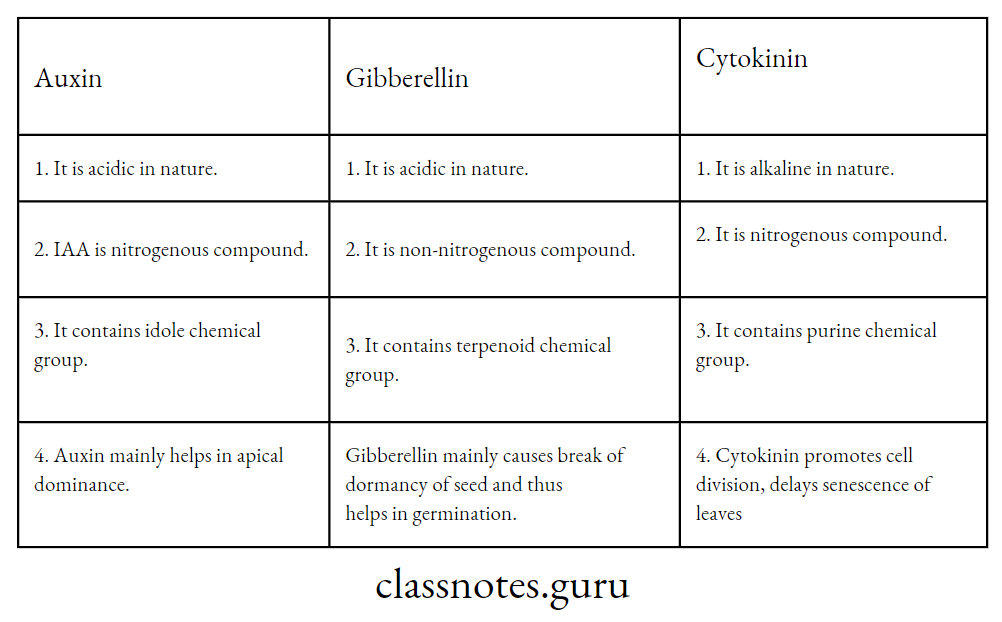
Synthetic/Artificial plant hormones :
There are various synthetic organic compounds that can stimulate plant growth and development. They can function in a very low concentration.
These chemicals like synthetic auxin, synthetic gibberellin are now widely used for obtaining better results in the field of agriculture and horticulture that can be discussed as follows :
Rooting of cutting—Plants like China rose, rose etc. generally reproduce vegetatively. They are usually propagated by cutting pieces of stem. When the cut stem piece is placed in moist sand, adventitious roots come out from the cut end.
This is called “rooting of cutting”. This process can be accelerated by pretreatment of cuttings with powders or solutions containing synthetic auxin. With this technique of cuttings, a large number of identical plants may be prepared from a single individual mother plant.
A good commercial product is available to farmers known as Olivia’s cloning gel which contains synthetic plant hormones that help in rapid growth of root from the end of cuttings.
Delay of preharvest fruit drop-ln plants, shedding of leaves, flowers, fruits etc. from stem is called abscission. Premature or preharvest drop of fruits (like apple, orange, and others) causes serious reduction in yield.
By the spray of synthetic plant hormones (like synthetic auxin and gibberellin) farmers can prevent premature drop of fruits—which is economically important in horticulture.
Control of weeds- Unwanted plants are called weeds, that can be effectively controlled by the application of synthetic hormones. Weed killing hormones are called herbicides. Synthetic hormones (herbicides) are dissolved in water and sprayed to field to control weeds.
Developing parthenocarpic fruit— Formation of parthenocarpic fruits (seedless fruits) can be induced by the application of synthetic auxin on different plants like Squash, Tomato,Strawberry etc
Response and: chemical coordination in Animals- Hormones:
Bayliss (1902) first observed that apart from carbohydrate, protein, fat, vitamins, minerals and water, there are some other unknown chemical substances, essential for normal growth and reproduction in the living body.
Bayliss and Starling (1904) termed this important chemical substance as “hormones”. In fact, they discovered the peptide hormone secretin (first discovered animal hormone) that primarily stimulates pancreas to secrete pancreatic juice.
The word hormone is derived from the Greek word hormao which means “I impel” or “I arouse to activity”.
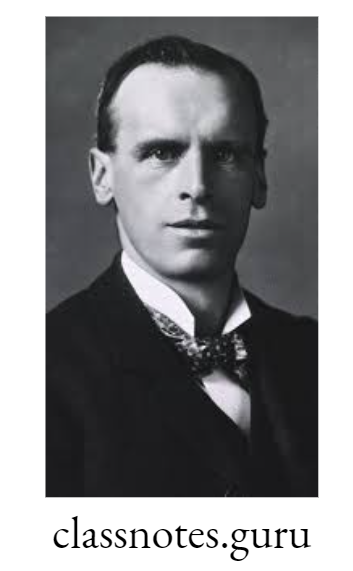
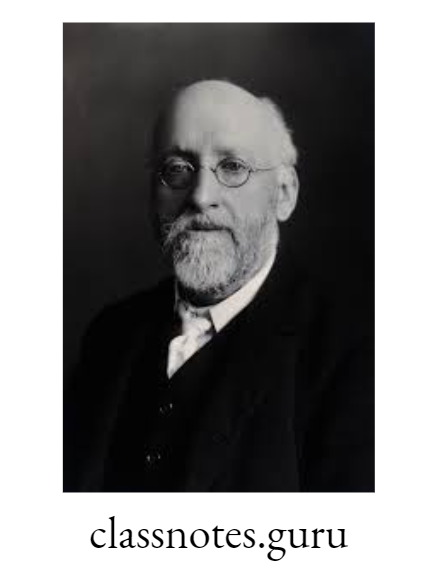
Definition: Animaj hormone is a biochemical messenger released from endocrine gland and is carried by body fluid or biood to a distant target organ where.it activates the metabolic process.
Need for regulation of different activities of the animal body (e.g. human) and the role of hormones :
Hormones play significant role in regulating basic important functions of our body that can be illustrated as follows :
Erection of body hair—Goose bumps / goose pimples/ piloerection are the bumps on a person’s skin at the base of body hairs which may develop involuntarily when a person is exposed to severe cold or experiences strong emotions like fear, pleasure, euphoria, nostalgia etc.
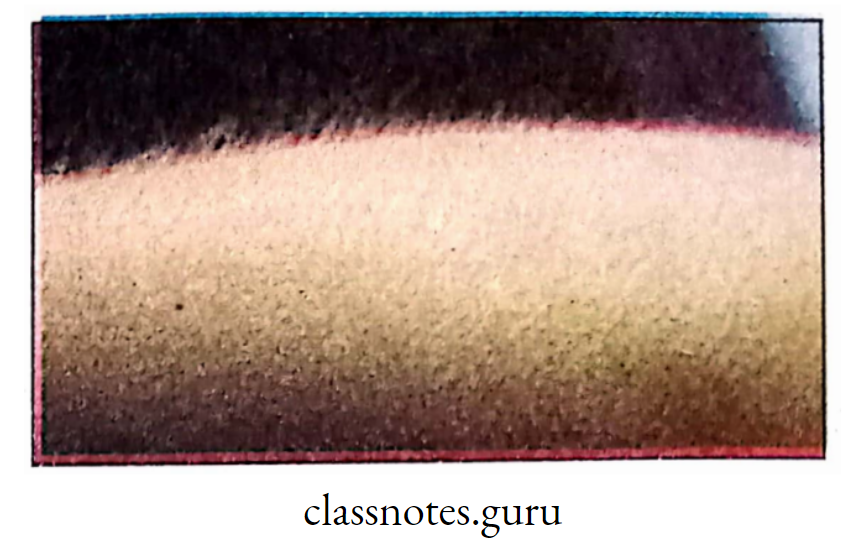
This pilomotor reflex or piloerection \s caused when tiny muscles at the base of each hair, known as arrector pili, contract and pull the hair erect. This is regulated by adrenalin (epinephrine) hormone secreted from adrenal medulla and the sympathetic nervous system.
Maintenance of constant level of glucose in blood—Blood sugar regulation is the process by which the level of blood sugar, primarily glucose is maintained in the body. Many hormones influence to control blood glucose level—some of them decrease blood glucose |eve| (blood glucose lowering hormone) whereas (blood glucose raising hormone).
Blood glucose lowering hormones are—Insulin (secreted from (3-cells of Islets of Langerhans in Pancreas) and to some extent Somatostatin (secreted some others increase blood glucose level from 5-cells of Islets of Langerhans).
On the contrary, blood glucose raising hormones are— Glucagon (secreted from a-cells of Islets of Langerhans in Pancreas), Adrenalin (fromAdrenal Medulla), Cortisol (from. Adrenal Cortex), ACTH, STH (fr0m Anterior Pituitary) and Thyroxin (from Thyroid gland).
Combating stress—Some hormones are secreted in the body during emergent condition (stress) |jke fear, anger, anxiety, hypertension, emotion, depression etc. These hormones are adrenalin (epjnephrjne) from adrenal medulla and cortisolfrom adrenal cortex.
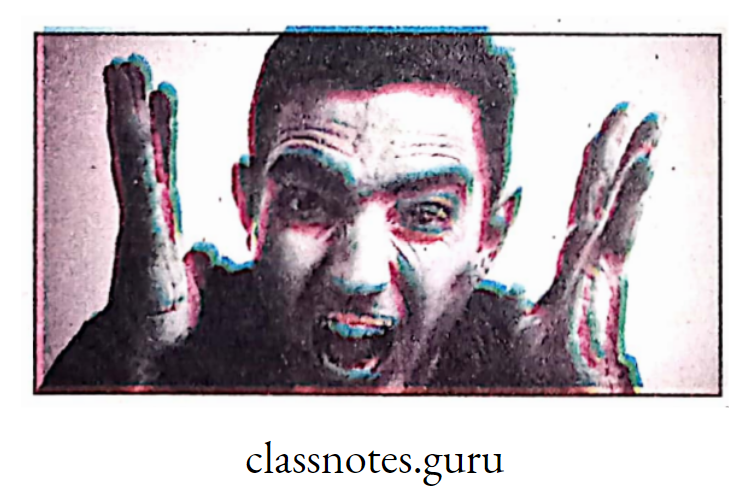
Adrenalin is known as emergency hormone or stress hormone,which causes widespread responses (such as increase of heart rate, lung breathing, blood pressure and so on) by which a subject is able to fight out situation successfully.
These responses are known as fight response or flight response.
Maintenance of blood pressure—Different hormones in the body influence blood pressure. Some important examples are as follows : –
- Adrenalin and noradrenalin hormones secreted from adrenal medulla raise blood pressure by increasing heart rate.
- Antidiuretic Hormone (ADH), produced by hypothalamus and released by posterior pituitary raises blood pressure by stimulating kidney.
- Atrial Natriuretic Peptide (ANP) or Factor (ANF), produced by atrium of heart lowers blood pressure by causing vasodilation.
- RAAS (Renin Angiotensin Aldosterone system)—Renin is a proteolytic enzyme secreted from luxt.i Glomerular Apparatus (JGA) of kidney. Angiotensin is a plasma protein whereas aldosterone Is the hormone from adrenal cortex. These three components work in co-ordination to control blood pressure.
Control of BMR—Thyroid hormones stimulate oxygen uptake and thus activate diverse metabolic activities in most tissues of the body. Hence these hormones increase BMR and are rightly called as calorigenlc hormone.
Control growth and secretion of reproductive glands— GTH (Gonadotrophic Hormone) is secreted from anterior pituitary that influences the functions of gonads (ovary in female and testis in male). It is of two types—FSH (Follicle Stimulating Hormone) and LH (Luteinislng hormone).
In females, FSH increases the size and weight of ovaries; LH helps in ovulation (release of ovum from ovary). Matured graafian follicle of ovary secretes oestrogen and progesterone (sex steroid).
In males, FSH induces development of seminiferous tubule and spermatogenesis whereas LH stimulates Leydig cells of testis to secrete testosterone (sex steroid).
Class 10 Science: Control and Co-ordination Key Concepts
Characteristics of animal hormones.:
Source— Animal hormones are secreted from endocrine gland (ductless gland). Pineal gland in the smallest endocrine gland whereas thyroid gland is the largest endocrine gland in human body.
Chemical nature—Animal hormones are of.following main types :
- Amino acid derivative—e.g. thyroxine;
- Polypeptide and protein—e.g. Insulin, STH;
- Glycoprotein—LH, FSH, GTH etc.
- Steroids (Synthesized from Cholesterol)—e.g. corticosteroid, testosterone, oestrogen, progesterone etc.
Mode of transport—Animal hormones are generally transported by blood or body fluid from the site of synthesis to the target organ (site of action).
Functions—In general animal hormone can regulate so many functions of the body—such as, growth/reproduction, metabolism and all physiological functions of the body
(like respiration, circulation, excretion etc.)
Fate of hormones—Animal hormones are required in.very small quantity (picogram = 10 12 gm) but they can not be stored in the body. So they are destroyed after their respective functions.
Hormone acts as ‘biochemical messenger’—Hormone is secreted from one endocrine gland and is carried to distant target organ by blood. Hormone alters metabolic profile in the target tissue as if the hormone is carrying the “message of metabolic change” from the endocrine gland to the target organ.
In fact, endocrine gland itself cannot move upto distant target organ but tries to control the function of the organ. So, it has to produce ‘information molecule’ called hormone that carries the message to desired target place. Hence the hormone is called as biochemical messenger.
Feed back control (e.g. TSH and thyroxine)—Feedback circuits are very prominent in the endocrine system. There are positive feedback but negative feedback is more common.- Negative feedback is seen when the output of a pathway inhibits inputs to the pathway’Autostart’ and ‘Autpcut’ of Ai.rconditioner, Microoven, Fridge etc. follow this negative and positive feedback principle.
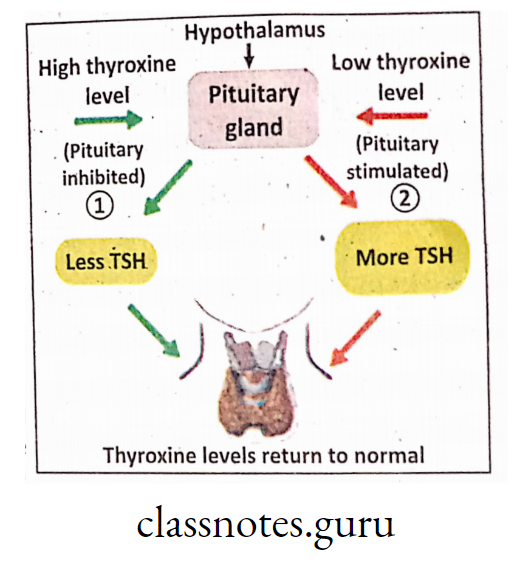
An important example of a negative feedback loop is seen in control of thyroid hormone secretion. Thyroid hormones-T3 (Triiodothyronine) and T4 (Tetraiodothyroxine) are synthesized and secreted by thyroid glands and influence metabolism all over the body.
The basic mechanism of negative feedback can be explained as follows:
Neurons in the hypothalamus secrete thyroid releasing hormone (TRH) RH/RF (Releasing Factor) which stimulates cells in the anterior pituitary to secrete thyroid stimulating hormone (TSH).
TSH stimulates the cells of thyroid gland to synthesize and secrete thyroid hormones that influence other target cells of the body..
When blood concentrations of thyroid hormones increase above the threshold limit, TRH—secreting neurons in the hypothalamus are inhibited resulting into stoppage of secretion of TRH.
Differences between Plant hormones and Animal hormones:
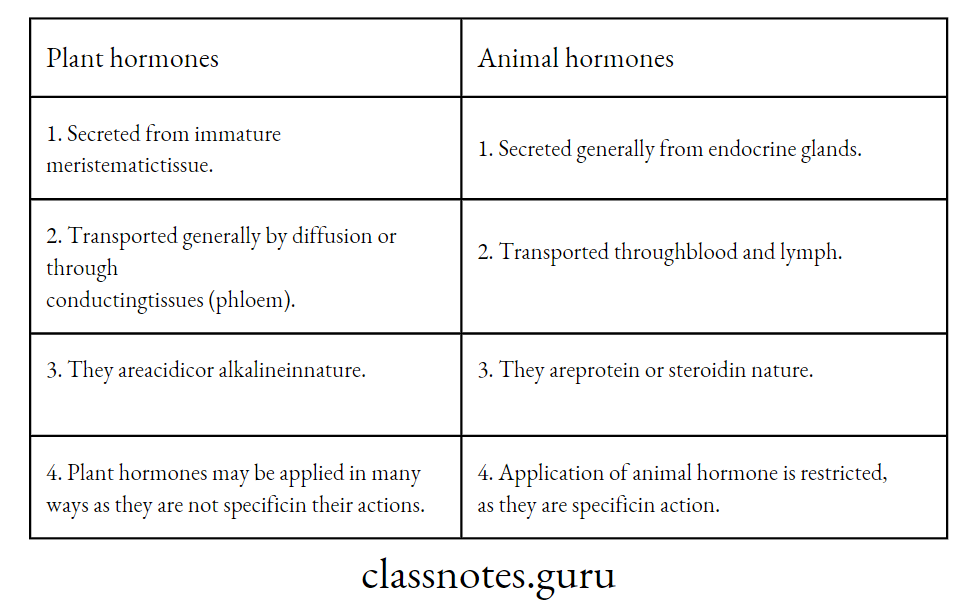
Human endocrine glands and the hormones secreted from them :
Hypothalamus: It is the basal part of fore brain.It is connected with the pituitary gland by a stalk called infundibulum. A portal blood vessel is connected between hypothalamus and hypophysis (pituitary gland) known as hypothalamic—hypophyseal portal vessel.
This vessel carries various releasing hormones (RH) or releasing factors (RF) and inhibitory factor (IF) or inhibitory hormone (IH) from hypothalamus to pituitary gland (Hypophysis). RF or RH stimulates pituitary gland to secrete a particular hormone whereas IF or IH causes inhibition of secretion, e.g.
GHRH (Growth hormone-releasing hormone) stimulates secretion of GH (Growth hormone) from anterior pituitary whereas GHIH (Growth hormone inhibiting hormone) inhibits secretion of growth hormone .
Posterior pituitary (Neurohypophysis) releases two hormones-ADH (Anti Diuretic Hormone) or Vasopressin and oxytocin. In fact, these two hormones are synthesized in Hypothalamus, carried to posterior pituitary and stored in posterior pituitary.
They are released from posterior pituitary as and when required (SOS).
General types of hormone in man:
The General hormone—The hormone which is secreted from one endocrine gland and acts on distant target organ is called general hormone, e.g. Insulin, Thyroxin etc.
Trophic hormone—The hormone which is secreted from one endocrine gland and acts on another endocrine gland as target organ is known as trophic hormone e.g. Anterior pituitary hormones like ACTH, TSH, GT.H etc.
Stress hormone/Emergency hormone—The hormone which is secreted under physiological stress or strain (‘ike fear, anxiety etc:) is considered as stress hormone or emergency hormone, e.g. Adrenalin.
Local hormone—The hormones that are released from several tissues of the body and act at the same site of origin or in nearby organs are designated as local hormone, e.g.
Gastrin (secreted from stomach and acts on stomach), secretin (secreted from duodenum and acts on pancreas) etc.
Pituitary gland (Hypophysis):
Location: Pituitary gland is situated under the brain within a small bony cavity, the sella turcica of the sphenoid bone.
The human pituitary gland is a small pea-shaped gland and remains attached with the brain by pituitary stalk (Infundibulum). It consists of two parts —anterior pituitary (Adenohypophysis) and posterior pituitary (Neurohypophysis)!
Pituitary gland is the very small endocrine gland in human body.
Anterior Pituitary :
Anterior pituitary consists mainly of two parts, such as- (i) pars tuberalis and (ii) pars distalis, which contain different secretory cells from where trophic hormones are secreted
Trophic Hormones: Those hormones which are secreted from the anterior pituitary and stimulate the different target glands for their growth and funtional activities are called trophic hormones.
since anterior pituitary performs a master role to control the funtional activities of the other endocrine glands of the body hence, anterior pituitary is sometimes called as “master gland” Or “master Of endocrine orchestra”. The six trophic hormones secreted are-
- ACTH — Adrenocorticotrophic Hormone or Adrenocorticotrophin.
- GH— Growth hormone or STHSomato Trophic Hormone.
- TSH— Thyroid Stimulating Hormone or Thyrotrophin. (4 + 5) GTH— Gonadotrophic Hormone or Gonadotrophin— Two types :
- FSH—Follicle Stimulating Hormone.
- LH— Luteinizing Hormone or Interstitial Cell Stimulating Hormone (ICSH).
- Prolactin— [Luteotrophic hormone (LTH) or Lactogenic hormone].
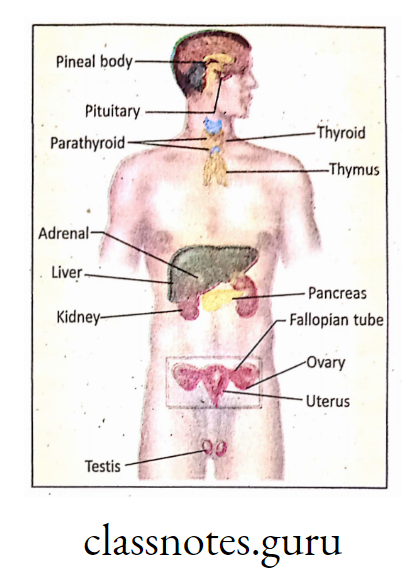
Adrenocorticotrophic Hormone- ACTH :
Site of secretion—ACTH is a protein (polypeptide) hormone secreted from the anterior pituitary.

Functions—
- it maintains the growth of adrenal cortex.
- It stimulates the secretion of hormones from the adrenal cortex.
Growth Hormone—GH or Somatotrophic Hormone :
Site of secretion—Growth hormone or Somatotrophic hormone (STH) is a protein hormone secreted from the anterior pituitary.
Functions—
- Effect of skeletal growth—GH (STH) helps in skeletal growth by stimulating multiplication of epiphyseal cartilage present at the tips, of the long bones.
- Effect on body growth—It stimulates for the growth of muscle and other body organs.
- Effect on metabolism—
- STH is a protein anabolic (synthetic) hormone,
- It rises sugar (glucose) level in the blood,
- It causes loss of body fat by mobilising depot fat.
Hypofunction of STH (GH) in childhood causes dwarfism.
Hyperfunction of STH in childhood causes gigantism and in adult acromegaly.
Thyroid Stimulating Hormone—TSH :
Site of secretion—TSH is a water soluble glycoprotein hormone secreted from the anterior pituitary.
Functions—
- Regulates growth of thyroid gland.
- It maintains the synthesis and secretion of thyroid hormones.
Hormonal Control in Living Organisms: NCERT Class 10 Science Notes
Gonadotrophic Hormone—GTH :
The trophic hormone which has influence over gonads (ovary or testis) is called gonadotrophin. It is of two types—FSH and LH.’
Follicle Stimulating Hormone (FSH) :
Site of secretion: It is a glycoprotein hormone secreted from the anterior pituitary.
Functions:
In females—
- It increases the growth of ovaries,
- It helps in the maturation of immature (primordial) follicles into mature follicles called Graafian follicles.
- It stimulates to secrete oestrogen (estrogen) from Graafian follicles.
In males—
FSH stimulates seminiferous tubules of the testis and causes spermatogenesis (process of formation of sperm). FSH also stimulates sertoli cells of testis.
Luteinising Hormone (LH) or Interstitial Cell Stimulating Hormone (ICSH) :
Site of secretion: LH is a glycoprotein hormone secreted from the anterior pituitary.
Functions:
In females—
- In presence of follicle stimulating hormone, LH ruptures the Graafian follicle thus helping in ovulation,
- It helps in the formation, maturation and persistence of corpus luteum.
- It stimulates to secrete progesterone from corpus luteum.
In males—LH stimulates the secretion of testosterone (a male sex hormone) by stimulating the interstitial cells of the testis (Leydig cell).
Luteotrophic Hormone (LTH) or Prolactin :
Site of secretion: It is a protein hormone secreted from anterior pituitary. Prolactin is also known as “maternity hormone” since this hormone is secreted during pregnancy,mainly during lactation.
Function:
- It stimulates development of mammary glands during pregnancy,
- It maintains secretion of milk from breast of a lactating mother.
- It helps formation of corpus luteum and stimulates secretion of progesterone from ovary.
Posterior pituitary (Neurohypophysis) :
Site of secretion: The antidiuretic hormone (ADH) or Vasopressin and oxytocin are the two.hormones, synthesized in hypothalamus, transported through NSC- and stored in posterior pituitary, from where they are released as and when required.
Functions:
- ADH stimulates reabsorption of water from the Distal Convoluted Tubule (DCT) of nephron and collecting tubule.
- In high dose, ADH rises blood pressure.
- ADH stimulates contraction of all smooth muscles—muscles of urinary bladder, ureter,intestine etc.
Oxytocin controls contraction of uterus during birth of the baby from mother’s uterus (parturition), secretion of milk from mother’s mammary gland etc.
Disorder of pituitary :
Gigantism: This is also known as giantism. This is characterized by excessive unusual growth in length much more than the average height (7′ – 9′). This’ is caused by overproduction of STH in childhood.
Dwarfism: See later (hormonal disorder).
Thyroid Gland :
Location: Thyroid gland is the largest endocrine gland of human body. The thyroid gland of man consists of two lateral lobes that lie on either side of the roof of trachea. They usually connected by a thin middle lobe called isthmus.
Site of secretion: Thyroid gland secretes thyroxin (Thyroxine). Essential component of thyroxin is iodine. Thyroxin is iodinated tyrosine.
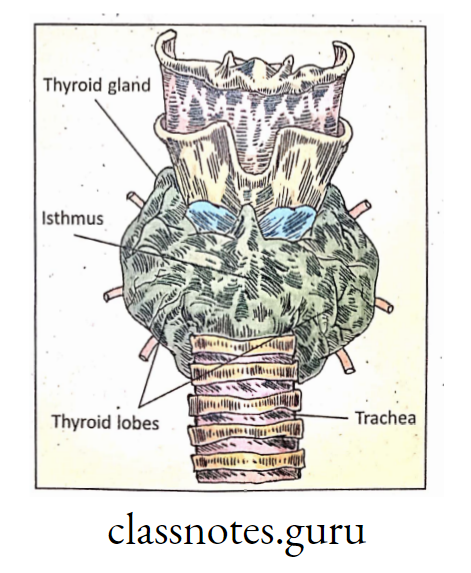
Function of thyroxin :
- Effect on B.M.R.—Thyroxin is a calorigenic hormone because it increases oxygen uptake and metabolism of the tissues and thus accelerates energy production i.e., B. M. R.
- Effect on metabolism— Thyroxin increases sugar level in the blood. In low dose it stimulates protein synthesis, but in high dose it depresses protein synthesis. Thyroxin decreases serum cholesterol and phospholipids.
- Effect on growth— Thyroxin helps in skeletal (bone), muscular, sexual and mental (nervous) growth.
- Effect on cardiovascular system— Thyroxin increase heart rate, cardiac output and blood pressure. It dilates peripheral vessels.
- Effect on respiration—It increase the utilization of 02 and formation of C02, thus increase the rate and depth of respiration.
- Effect on gastrointestinal tract—Thyroxin increases absorption of food, secretion of digestive juices and movement of gastrointestinal tract (peristalsis).
- Effect on breast— Stimulates milk secretion from breast.
- Effect on blood cells—Thyroid hormone helps in the development of R. B. C. (erythropoiesis). Hypofunction of thyroid causes anaemia.
- Effect on regulation of body
temperature—Thyroxin is a heat producing (calorigenic) hormone. It increases body temperature. - Effect on metamorphosis— The metamorphosis of tadpole into toad is one of the important function of thyroid hormone.
Diseases of thyroid :
Myxoedema—This disease develops due to hyposecretion of thyroid gland in adult. This is characterized by puffy eyes, face, hands along with mental retardation. However, :
myxoedema may develop both in hypothyroidism and hyperthyroidism.
Cretinism—This disease develops in children due to congenital (since birth) thyroid
hormone deficiency. It causes mental retardation, dwarfism. ’
Adrenal Gland :
Location: A pair of roughly triangular human adrenal glands are situated on the upper pole of each kidney. So it is known as Suprarenal gland. Each adrenal gland consists of outer
cortex and inner medulla.
Site of secretion—The adrenal medulla secretes adrenalin and noradrenalin.

Adrenalin is known as emergency hormone. Because the rate of secretion from adrenal medulla increases during emergent conditions, such as—fear, anxiety, emotionalconditions, etc. to cause widespread
responses by which a subject is able to fight out situation successfully. These responses are known as fight and flight responses.
Functions —
- Effect on heart Contraction and relaxation of heart, heart beats and cardiac output are increased by the action of adrenalin.
- Effect on blood vessels— Adrenalin constricts all blood
vessels, but it dilates coronary vessels and vessels of skeletal muscles - Effect on blood pressure—Blood pressure Increases due to constriction of blood vessels and due to Increase
of heart rate. - Effect on respiration—Adrenalin causes dilation of bronchioles and Increases the rate and depth of respiration.
- Effect on skeletal muscle—It Increases excitability,
contractility and tone of the skeletal muscle. It causes delay in fatigue. - Effect on smooth muscle—Adrenalin inhibits the tone of the Involuntary muscle present In the stomach,
intestine and bronchiole. Intestinal movement is inhibited. It causes contraction of spleen, dilatation of pupil, etc. - Effect on skin and regulation of body temperature—Adrenalin constricting cutaneous vessels thus decreases flow of blood which prevents loss of body temperature.
- Effect on kidney—It decreases renal circulation, thus decreases urine volume.
- Effect on metabolism—Adrenalin increases blood sugar by stimulating breakdown of liver glycogen, formation of glucose from lactic acid (neoglucogenesis), etc.
- Effect on secretory functions—Adrenalin stimulates secretion of saliva, lacrynrial secretion, sweat (horse and sheep), etc.
Noradrenalin (Norepinephrine) :
Site of secretion: The adrenal medulla secretes noradrenalin.
Functions :
- Effect on heart—It increases heart rate slightly.
- Effect on blood pressure—It enhances both systolic and diastolic blood pressure.
- Constriction of blood vessel —It constricts arterioles to enhance peripheral resistance and thus increases blood
pressure. - Widening of pupil of eye.
- Air passage —Noradrenalin widens air passage to
lungs—thus increases inspiration. - Muscle— Noradrenalin stimulates contraction of skeletal muscle.
The function of adrenalin and noradrenalin are more or less same except a few as follows:
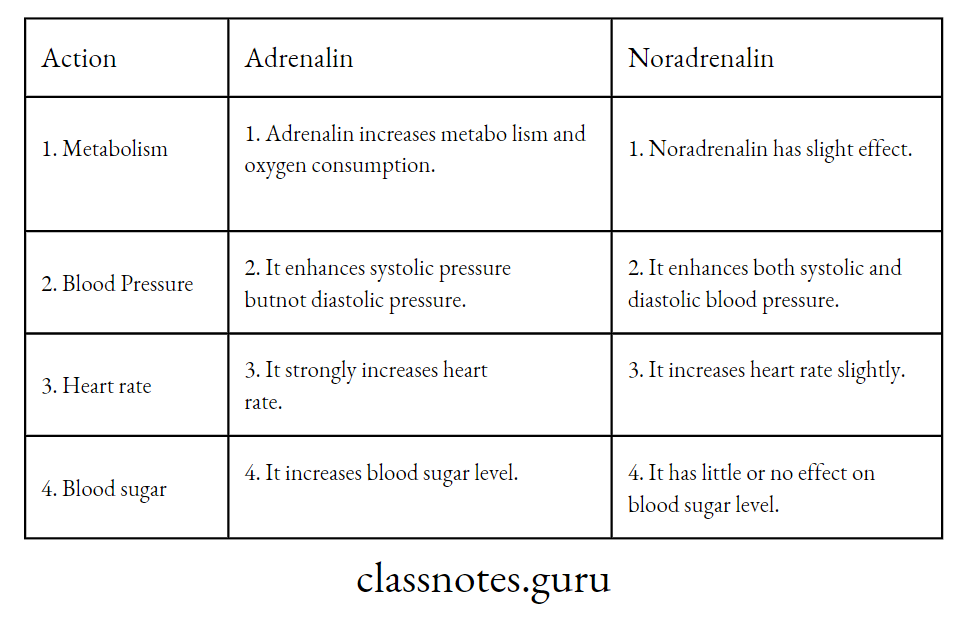
Endocrine Pancreas :
Location: Pancreas is situated below the stomach, connected with the duodenum. It is a mixed gland consisting of both exocrine part (Acini) and endocrine part (islets of Langerhans). Maximum Islets are clustered in the tail region of pancreas. The Islets of’ Langerhans are groups of cells present in between the exocrine cells of pancreas.- The Islets of Langerhans contain mainly a (alpha), (3
(beta) and 8 (delta) cells.
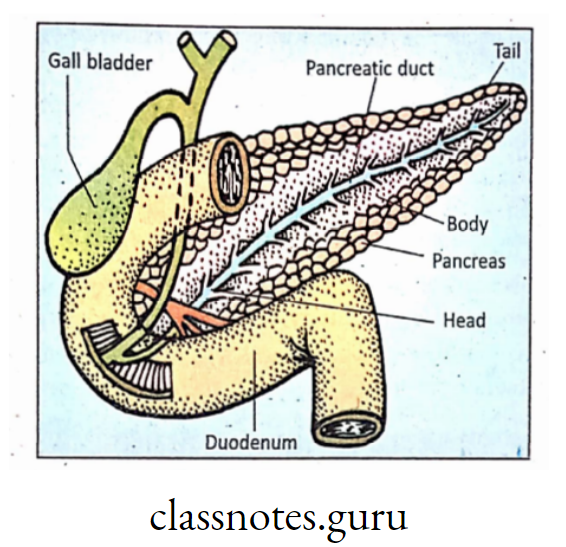
Hormones secreted: Two principal hormones secreted from pancreas are Insulin and Glucagon.
Insulin : (a) Site of secretion— Insulin is a protein hormone secreted from the (3-cells of Islets of Langerhans of the pancreas.
Functions of Insulin—
Effect on carbohydrate metabolism—Insulin is known as an antidiabetogenic hormone because insulin prevents Diabetes Mellitus by lowering blood sugar (Hypoglycemic) with following processes:

Oxidation of glucose—Insulin increases the activity of the hexokinase enzyme in the cells and thus increases oxidation (utilization) of glucose , in the cell,
Synthesis of glycogen—Insulin .stimulates the formation and storage of glycogen in the liver and muscle taking glucose from blood,
Inhibits gluconeogenesis—Formation of glucose from protein, fats etc i.e., from the non-carbohydrate sources is called gluconeogenesis. This process is inhibited by insulin,
Permeability of membrane—Insulin increases entry of glucose into somatic ceils from blood by increasing permeability of cell membrane.
Effects on protein metabolism—Insulin helps in protein synthesis in the body by preventing gluconeogenesis.
Effects on fat metabolism—Insulin decreases the lipid and cholesterol in blood
Glucagon :
Site of secretion: Glucagon is secreted from alpha cells of Islets of Langerhans of pancreas
Functions of Glucagon :
- Anti-insulin function—It increases blood sugar level. So it is hyperglycemic in function.
- Effect on carbohydrate metabolism—It stimulates break down of liver glycogen into glucose (glycogenolysis) which increases blood glucose level,
- Effect on protein metabolism—Glucagon hydrolyses protein into amino acids.
- Effect on fat metabolism—It increases fat’ and cholesterol level in blood.
Hence Insulin and Glucagon are antagonistic hormone. In human body, normal blood sugar (glucose) is balanced by the action of both the hypoglycemic insulin and hyperglycemic glucagon hormpnes.
Gonads: Gonads are the reproductive organs of human body. They are testis in male and ovary in female. Both testis and ovary are considered as mixed gland.
Testis (Gonad of male) : (Exocrine secretion of testis is sperm)
Location—Human testis are oval shaped paired structures which remain suspended in
scrotum or scrotal sac that is present outside the body in between two legs.
Testis secretes the male sex hormone called Testosterone.
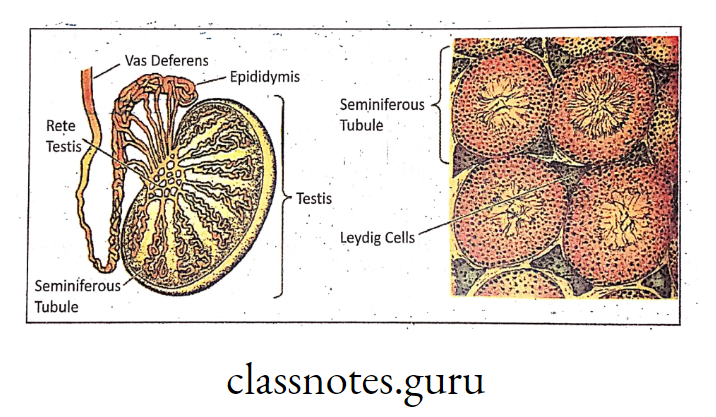
Class 10 Science Chapter: Control and Co-ordination Review
Site of secretion: Interstitial cells of Leydig in testis.
Functions:
- Testosterone stimulates growth and development of primary sex organ (testis), secondary sex organs (scrotum, penis, sex glands) secondary sex characters,
- It causes puberty, changes * muscular growth, breaking of voice, growth of hair on face, axillae, chest, etc.
- It stimulates RBC formation (erythropoiesis).
Ovary (Gonad of female) :
Location—Ovary is the primary sex organ or gonad of female body. Two ovaries are present at the pelvic region of female body in both sides of abdomen. (Exocrine secretion of ovary is ovum)
Ovary secretes two important female sex hormones called Oestrogen and Progesterone.

Oestrogen :
Site of secretion of Oestrogen :
- Graafian follicle of ovary,
- Chorionic villi of placenta and
- Adrenal cortical gland.
Functions of Oestrogen :
- Oestrogen stimulates the growth, development and functional activities of primary and secondary sex organs in females,
- Oestrogen regulates menstrual cycle and stimulates breast development,
- It stimulates deposition of fat in the body.
Progesterone :
Site of secretion of Progesterone :
- Corpus luteum,
- Chorionic villi of placenta and
- Adrenal cortical gland.
Functions of Progesterone :
- Progesterone in presence of Oestrogen stimulates full
development of primary and secondary sex organs, - It regulates menstrual cycle and stimulates the development of breast.
- Progesterone helps in the embedding of embryo (implantation) in the uterus and stimulates the development and maintenance of pregnancy.
After ovulation, the empty graafian follicle without ovum is called Corpus Luteum which secretes the hormone progesterone. Corpus Luteum is a temporary endocrine gland.
A Causes and Symptoms of some common hormonal disorders (Dwarfism, Diabetes Insipidus, Goitre and Diabetes Mellitus) :
Dwarfism :
Causes: Hyposecretion of STH (GH) fr0m anterior pituitary
Stunted growth.
Symptoms:
- In young children, undergrowth, about 3-4 feet height.
- Intelligence remains almost normal.
- Sometimes, there may be excess deposition of fat in the body,
round face, no beard or moustache.
Diabetes Insipidus :
Causes: Hyposecretion of ADH (Vasopressin) from this problem.
Symptoms:
Due to less ADH, there is less reabsorption of water through the renal tubule of nephron. So, huge amount of water is lost from the body along with urine. Hence there is frequent urination (polyuria) and dehydration. To compensate the water loss, there is repeated feeling of thirst (Polydipsia).
There is decrease of blood pressure.
Normal function of stomach, intestine, urinary bladder is disturbed.
Goitre :
Causes: Enlargement of thyroid gland due to hyperthyroidism or hypothyroidism is called Goitre.
Hyperthyroidism—results Into Exopthalmic goitre or Graves’ disease. Important symptoms are—
- Enlargement of thyroid gland causing swelling of neck.
- Protrusion of eye ball due to deposition of fat behind the eye ball.
- Decrease of body weight.
- Increased heart rate and rise of blood sugar.
- Higher BMR, body temperature, excessive sweating, nervousness etc.
Hypothyroidism (endemic goitre) may result into tremendous nlargement of thyroid gland and front part of neck.
Common Symptoms are as follows :
- Some people may have inadequate dietary intake of Iodine. So there will be low level of thyroid hormone in blood (since Iodine is the essential component of thyroid hormone).
- Tremendous weakness and fatigue condition of the body.
- Weight gain.
- Dry, rough skin, coarse dry hair.
- J Hair loss (alopecia).
- Muscle cramps and frequent muscle pain.
Diabetes mellitus :
Causes: HypoSecretion of insulin causes diabetes mellitus. Due to less secretion or lack of insulin, amount of glucose in blood increases known as hyperglycemia. When the amount of glucose in blood crosses renal threshold limit (more than 180 mg/100 ml blood) excess glucose may be eliminated along with urine called glycosuria.
Normal blood sugar level :
Fasting—80 mg% (per 100 ml blood)
After meal (Post Prandial—PP) —120 mg% (per 100 ml blood)
There are two types of diabetes mellitus—type-1 and type-ll.
Type-1 diabetes is due to destruction of pancreatic Beta celis.So no insulin is produced from the pancreas. Hence the patient has to take exogenous insulin injection. So, type-1 diabetes is called Insulin Dependent Diabetes Mellitus (IDDM).
Type-2 diabetes is known as ‘Life style Diabetes’ which is Non-insulin Dependent Diabetes Mellitus (NIDDM).More than 90% of diabetic patients suffer from Type-ll diabetes.
Some common causes of type-ll diabetes may be as follows :
- Eating too much and exercising too little.
- Obesity and high abdominal fat.
- Eating food of high calorie.
- Physical inactivity and s’edentary life.
- Sleep habits—sleeping less than five hours a night.
- Genetic inheritance.
- Very high stress level.
Symptoms: Symptoms of Type-1 and Type-ll diabetes are common, There are three ‘polys’—
- Polyuria—Frequent urination since kidney cannot absorb sufficient water.
- Polydipsia—Frequent feeling of thirst to compensate water loss.
- Polyphagia—Frequent feeling of hunger.
- Weight loss.
- Fatigue and tiring condition of the body.;
- Sensation of numbness in the hands or feet. .
- Blurred vision.
Control and Co-ordination in Humans: NCERT Class 10 Notes
Exocrine, Endocrine and Mixed glands:
Definition: Any specific cell or tissue or organ of the body, that can -secrete particularchemical substances for use in the body or for discharge into surroundings is called as gland.. Largest gland in human body is liver whereas smallest gland in human body is goblet cell (secreting mucus).
Exocrine gland: The ducted gland that commonly secretes-enzymes is- called as exocrine gland, e.g. Salivary gland, Liver, Intestinal gland, Gastric gland, Sweat gland; Sebaceous gland, Mammary gland etc.
Endocrine gland: The ducttess giand that secretes hormones- is called endocrine gland. The secreted hormone directly diffuses into blood. e;g. Pituitary gland, Thyroid gland,Adrenal gland.
Mixed gland: The gland which is both exocrine and endocrine in function (i.e. can secrete both enzyme and hormone) is’ called as fnixed gland, e.g. Pancreas, Testis and Ovary.
Difference between Endocrine and Exocrine gland :
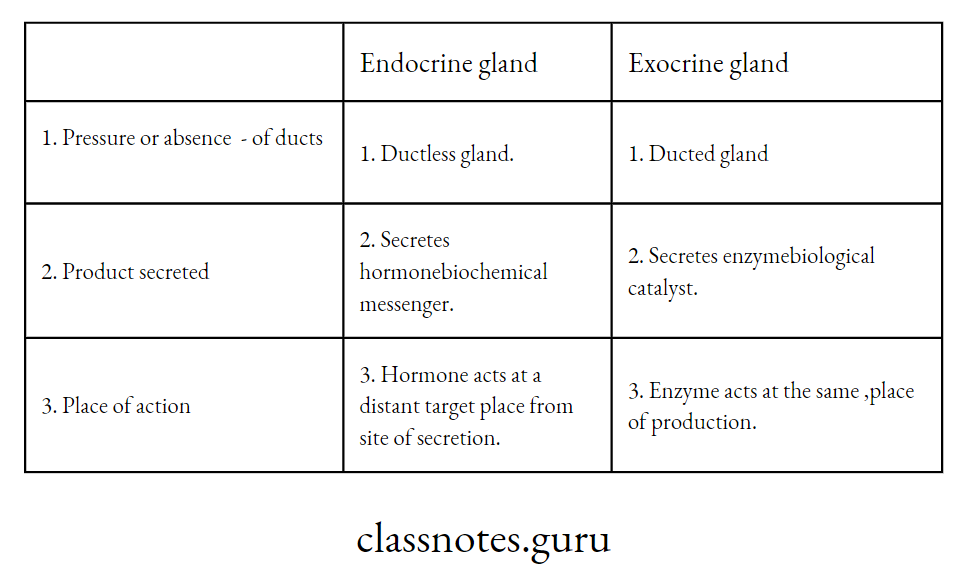
Difference between Thyroxin and Adrenalin :
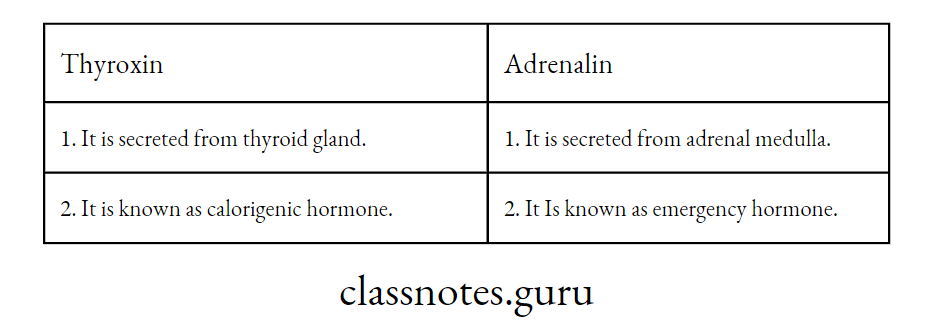
Difference between Hormone and Enzyme :
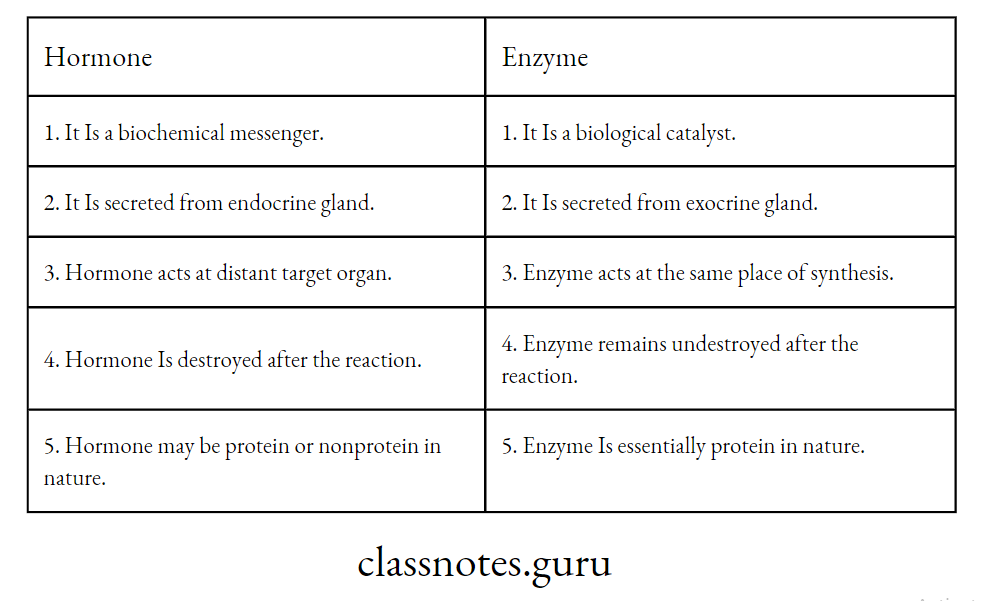
Difference between Insulin and Glucagon :
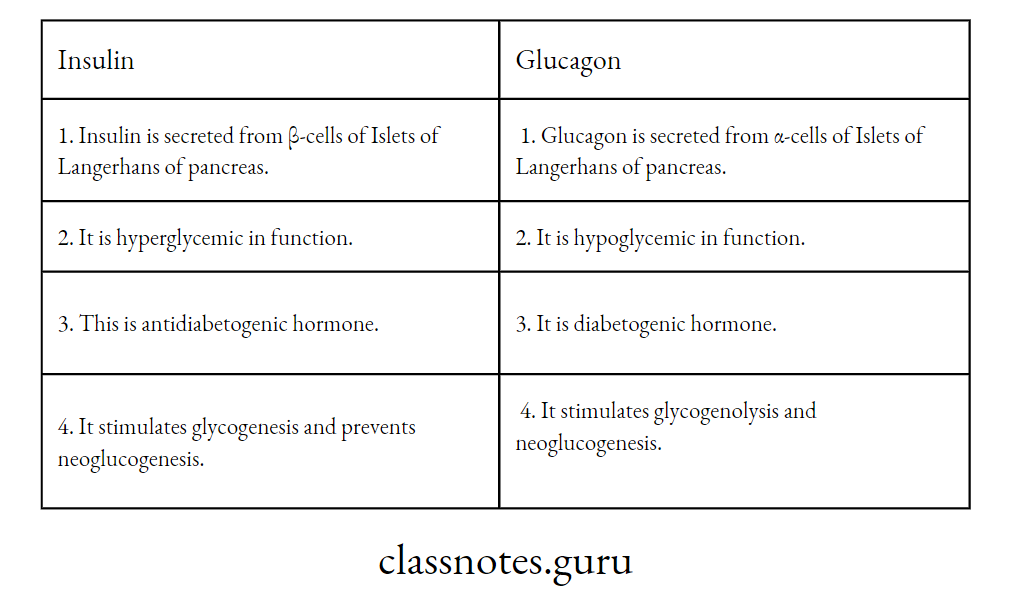
Glycogenesis is the process of formation of glycogen from glucose. Neoglucogenesis or gluconeogenesis is the process of synthesis of carbohydrate from noncarbohydrate (protein, lipid, amino acid etc.) source.
Difference between Diabetes mellitus and Diabetes insipidus :
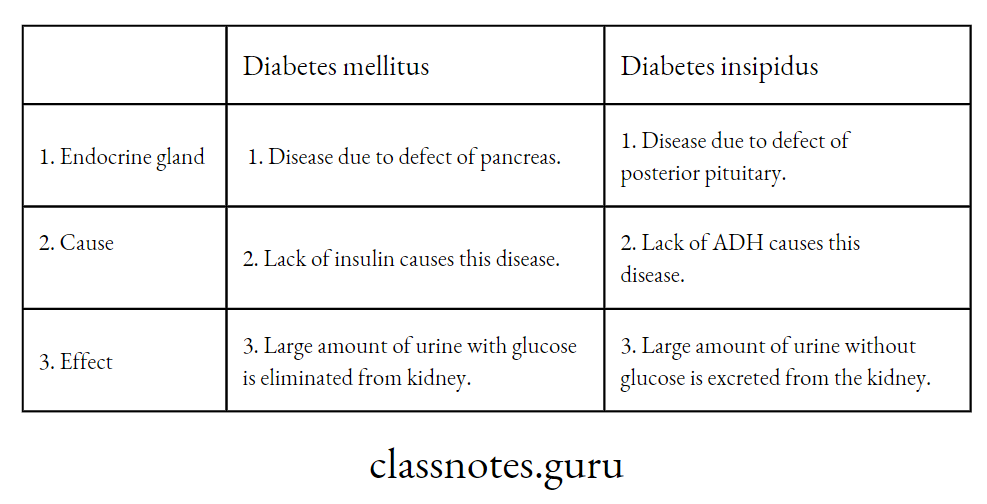
Response and physical coordination Animals- Nervous system:
Neural control and coordination (What is neural control and coordination ?).
There are frequent changes in the external surrounding and internal environment of our body. A system is required that will be informed and aware of all those changes. The system controls various functions, regulates different activities and coordinates all systems of the body.
Two controlling systems in. the animal body are—
The rapid controlling’ system (comprising nervous system) and
The slow controlling system (comprising endocrine system).
Nervous system may control and regulate one particular activity but coordinates various activities. Nervous coordination is brought about by the neurones, nerves, nervous system and sense organs.
One common example from daily life :
Someone is running: This is an action but this action is coordinated by many other functions of the body that can be” explained as follows :
- During running, leg muscles as well as other muscles of the body contract and expand vigorously.
- For this action of muscle, huge quantity of extra energy is needed.
- So, lungs breathe faster and deeper to absorb more oxygen.
- To distribute more oxygen to different parts of the body, heart rate increases and thus heart pumps blood to various organs of the body at a faster rate.
- Hence, there is sharp increase in cellular respiration causing higher rate of glycolysis,Krebs cycle, ETC and so on to produce greater quantity of energy that is required for faster contraction of different muscles, particularly leg muscle.
- As the blood flows to brain, the brain detects changes in oxygen and C02 content of blood and sends nerve impulses to the diaphragm, intercostal muscle and heart.
- All the above “functions of different system are coordinated by nervous system of the body.
Nervous pathway (How do animals respond to stimuli ?)
One of the fundamental characteristic of living organisms is their ability to respond to stimuli. This is known as irritability or sensitivity.
Stimulus: Any physicochemical change in the external or internal environment of an animal that can generate an impulse in the nerve is called stimulus.
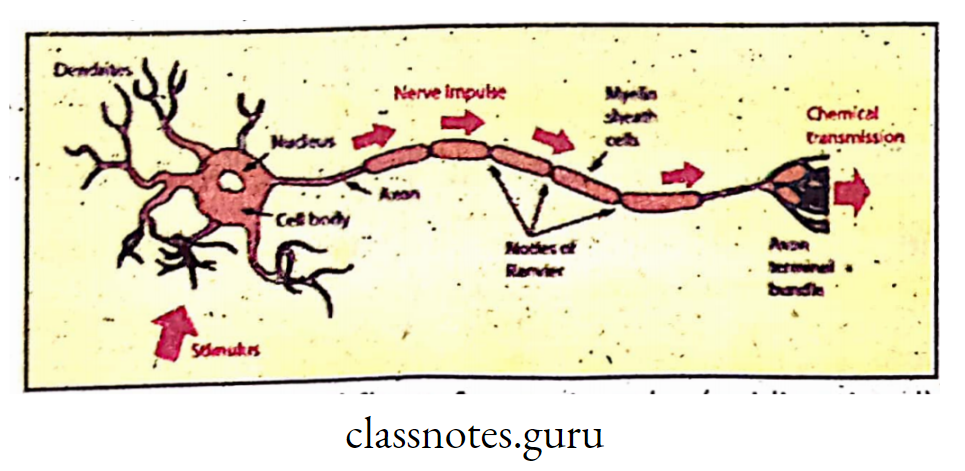
External stimulus may be heat, light, sound etc. .
Internal stimulus may be pain; pressure,hunger, fear, anxiety etc.
Mechanism of Control and Co-ordination in Plants and Animals
Receptor: Any organ or part of the body that can receive a stimulus is called receptor, e.g. watching of cricket ball by the batsman with eyes. Here.Eye is the receptor (Photo-receptor); Hearing a song, Ear is. the receptor for sound (Phonoreceptor); Nose’is the receptor for smelling (Olfactoreceptor); Skin is the receptor for touch (Tangoreceptor); Tongue is the receptor for taste (Gustato-receptor) and so on.
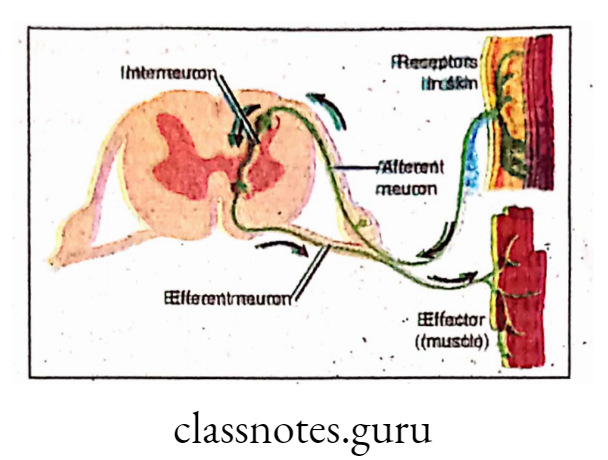
Effector: A muscle or gland or an organ capabie of responding to a. stimulus (especially a nerve impulse) is called as effector. Effector brings about .response, e.g’. the batsman watches the ball with eye(receptor) and plays the ball with bat holding in hand(effector).
Pathway of flow of impulse :
Between the receptors and’ effector there are theconducting cells of the nervous system,termed neurons. Neurons are the basic structural and functional.units of the nervous system.
They are distributed throughout the bodyforming a complex network of communication:
Example 1: Opening the door by hearing the door bell.
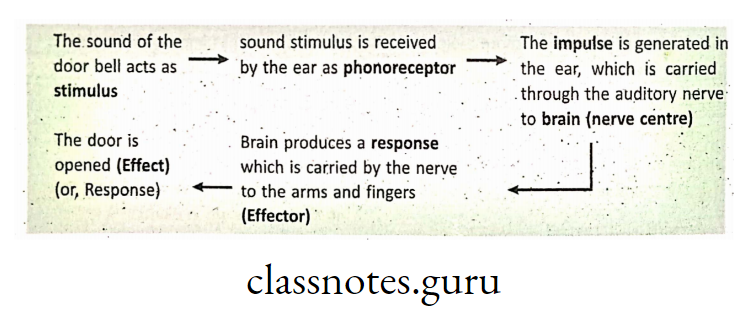
Example 2: Playing the cricket ball by a batsman.
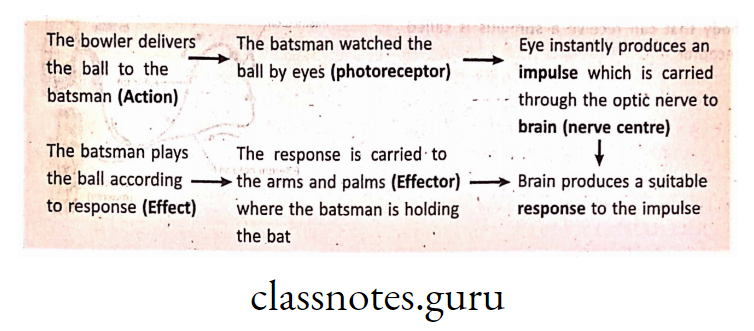
Example 3: A student writing the answer in examination hall.

Difference between mode of action of hormone and nervous system :
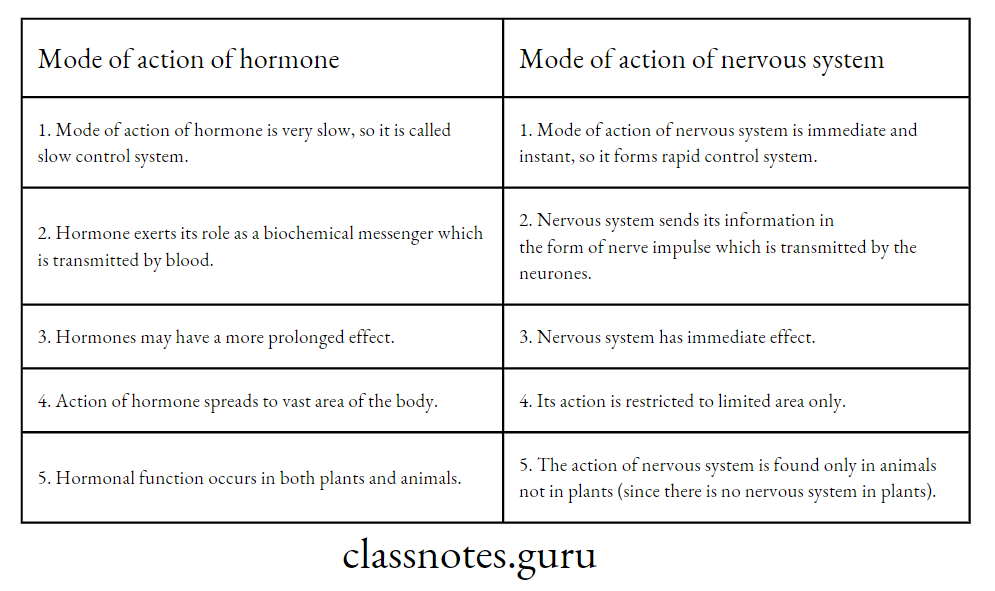
Components of Nervous system :
Neuron, Neuroglia and Nerves :
The nervous system consists of brain, spinal cord and nerves. All these structures are,made up of neurones and neuroglia.
Structure and Function of different parts of Neuron :
Neuron is the structural and functional unit of nervous system.
Each neuron is. made up of cell body and the processes (dendrites and axon).
Difference between Axon and Dendron :
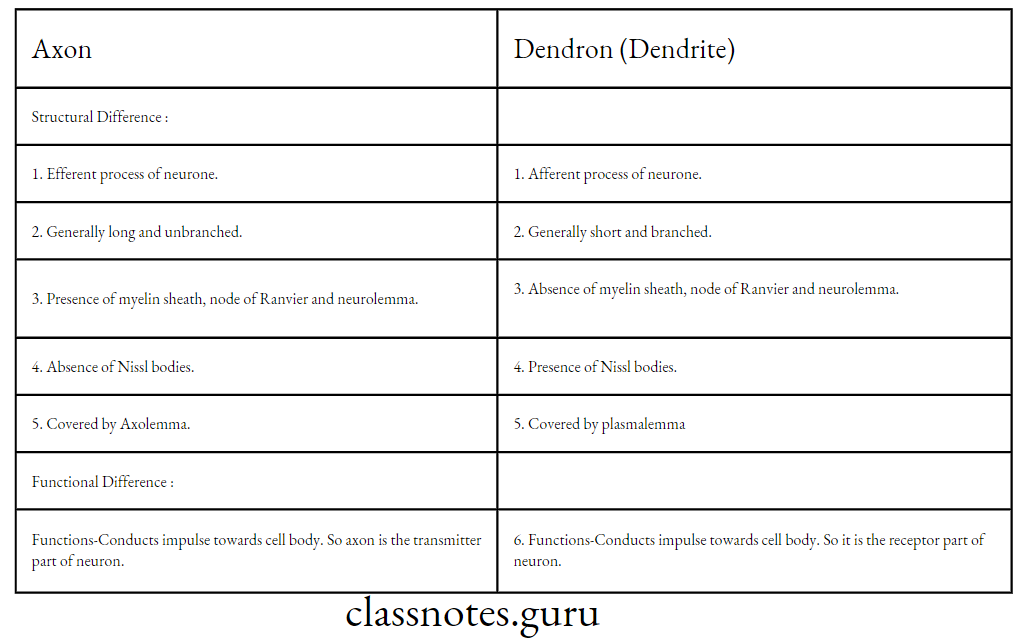
Difference between Medullated or Myelinated and Non-medullated myelinated nerve fibres :
Class 10 Science: Control and Co-ordination Key Concepts
Neuroglia :
Definition: The fibrous and cellular, non-nervous supporting elements of the nervous system are called neuroglia.

The number of neuroglia cells are much more then the neurones. About ten percent of the total cells in the nervous system are neurones and remaining ( about 90 percent) are neuroglia
Examples: Neuroglia are mainly of three types- oligodendroglia, astrocytes, and microglia.
Functions :
- Support,
- Insulation and
- Phagocytosis.
Types of Neurone : Sensory, Motor, Adjustor/lriterneurone.,
Sensory (Afferent) Neurone—The neurone that transmits the sensory nerve impulse from receptor to CNS (Central Nervous System) is called sensory or Afferent neurone.
Motor (Efferent) Neurone—The neurone that carries the motor response (impulse) from CNS (Central Nervous System) to the effector organs is called Motor or Efferent neurone.
Adjustor/lnternuncial neurone (Interneurone)—A nerve cell found entirely within the central nervous system, that acts as a link in between sensory neurone and motor neurone is known as adjustor neurone or internuncial neuone.

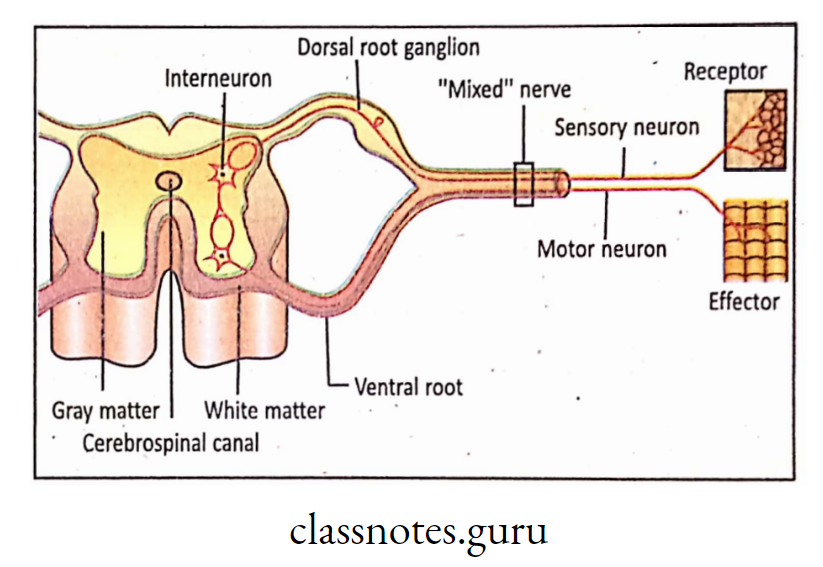
Mixed nerve—The nerve which has both afferent and efferent fibres is called mixed nerve, e.g. Spinal nerves.
‘Interrelationship between Neurones, Nerve fibres and Nerve:
A thread like process of a neurone,especially the prolonged axon that conducts nerve impulse is called nerve fibre.
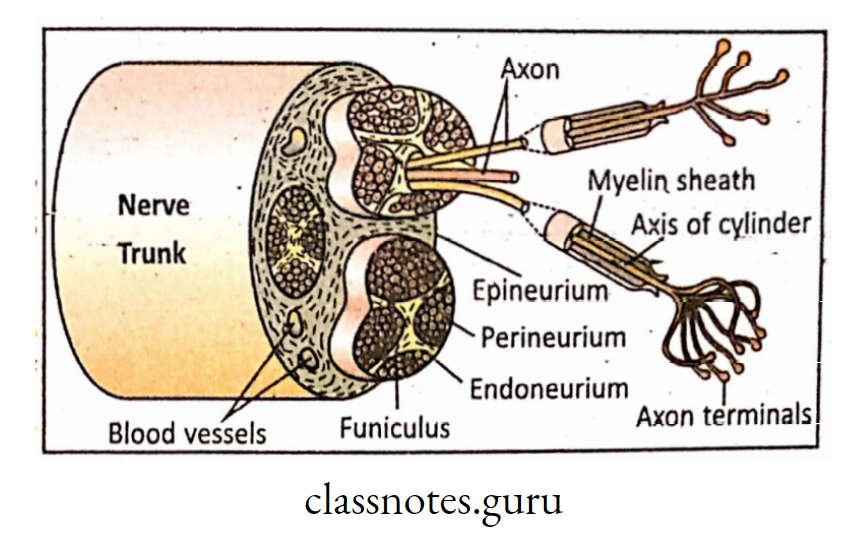
Definition: The bundle of nerve fibres enclosed by the membranous layers of connective tissue (endoneurium, perineurium and epineurium) is called nerve.
The connective tissue layer surrounding the individual nerve fibre (generally to the axon) is called endoneurium. Bunch of nerve fibres or axons are bounded together to form a bundle which is covered by another connective tissue sheath called perineurium. Each bundle is known as funiculus.
Several such funiculus are bound together by another outermost connective tissue layer called epineurium.
Types of Nerve (According to function) :
Afferent (Sensory) nerves—Those nerves which are made up of sensory neurones and transmit nerve impulse from the receptors into the central nervous system are known as sensory nerves or afferent nerves.
Examples—Olfactory nerve (1st Cranial nerve), Optic nerve (2nd Cranial nerve), Auditory / Vestibulocochlear / Acoustic nerve (8th Cranial nerve).
Efferent (Motor) nerves—Those nerves which are made up of motor neurones and transmit impuls’e (Response) from central nervous system into the effector organs are known as motor nerves or efferent nerves.
Examples— Occulomotor nerve (3rd Cranial nerve),Trochlear nerve (4th Cranial nerve), Abducens nerve (6th Cranial nerve), Spinal acessory nerve (11th Cranial nerve); Hypoglossal nerve (12th Cranial nerve).
Mixed nerves— Those nerves which are made up pf both sensory and motor neurones are called mixed nerves. They carry the nerve Impulse from periphery (receptors) to the centre (sensory impulse) and from centre to the periphery (the muscle) or effector organs (motor impulse).
Examples—Spinal nerves, Vagus (10th cranial) nerve, etc.
Difference between Afferent and Efferent nerves :
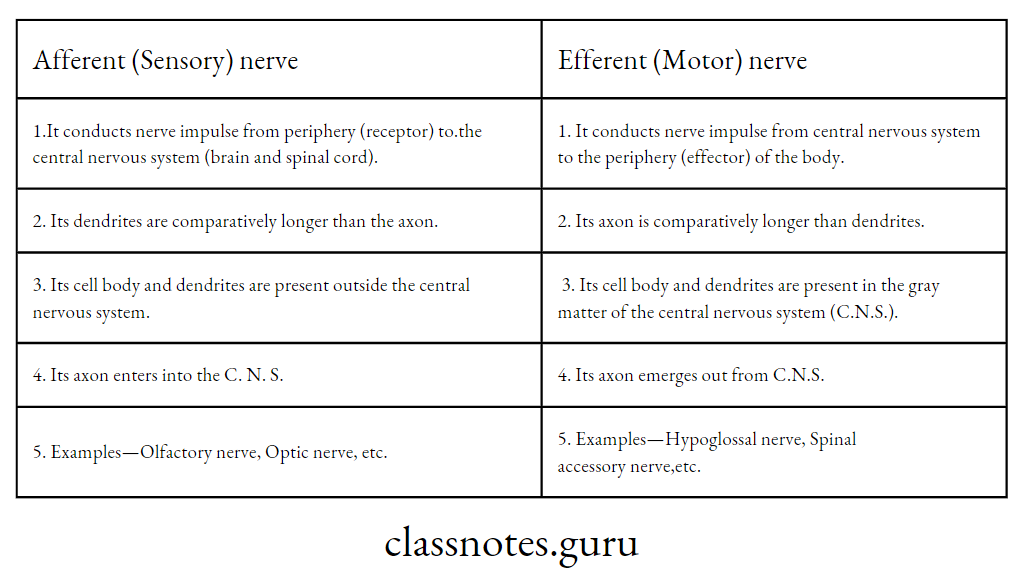
Ganglion (pi. Ganglia) :
Definition: A group or collection of nerve cell bodies ensheathed by connective tissue and located outside the central nervous system (Brain and Spinal cord) is called ganglion. So ganglia are the part of peripheral nervous system.
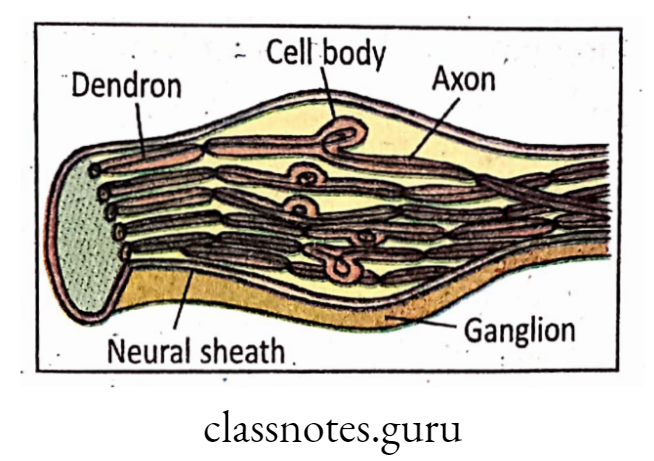
Cells found in a ganglion are called ganglion cells. Ganglia often interconnect with other ganglia to form a complex system.
Function of ganglia :
- Ganglia are mostly associated with sympathetic nervous system and their functions are related to the activities of heart, glands and involuntary muscles.
- Ganglia act as relayonly station among CNS, PNS and various organs.
Synapse :
Definition: Synapse is the junctional gap between two consecutive.neurons where one neuron ends and another neuron begins.
Location of Synapse: Synapse is located in between two neurons. Generally, synapse is formed in between axon terminals of the previous neuron and dendrites or cyton of the following neuron.
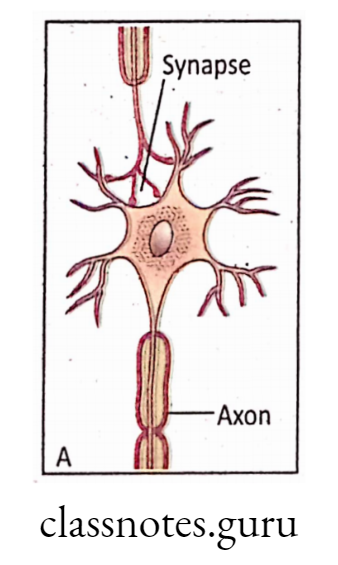
NCERT Class 10 Science Notes: Control and Co-ordination
Types of Synapse : According to formation the synapses are of
three types :
- Axodendritic synapse—It is formed by an axon terminal of one neurone and dendrite of another neurone.
- Axosomatic synapse—It is formed by an axon terminal of one neurone and soma (cell body) of another neurone.
- Axoaxonic synapse—It is formed by an axon terminal of one neurone and axon of another neurone.
Functions of Synapse :
Synapse allows synaptic transmission of the nerve impulse to conduct in one direction (forward conduction) only i.e., from axon terminals of the previous neuron to the dendrites or cell body of the following neuron with the release of neurotransmitter.
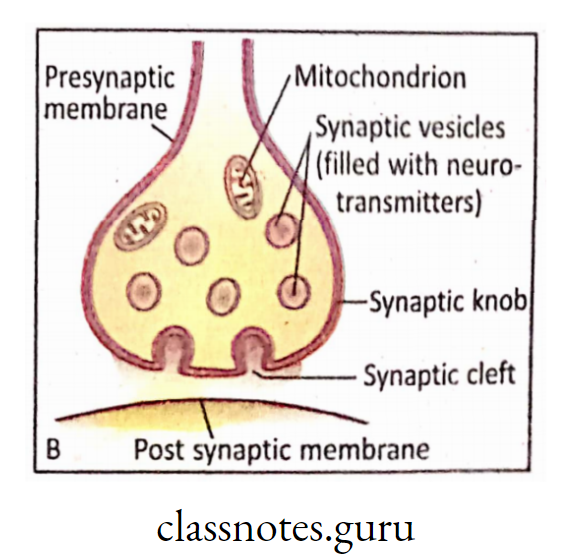
Synapse converts the nerve impulse into convergent or divergent type of impulse,
It converts a particular stimulation into excitatory or B inhibitory type of impulse,
Due to repeated stimulations, probably due to exhaustion of neurotransmitter substance in synaptic vesicle,synapse acts as a seat of fatigue in the central nervous system.
Neurotransmitter and its Role in Transmission of Nerve Impulse :
Definition: Neurotransmitter is a neurochemical substance which helps in synaptic transmission of impulse from one neuron to another neuron or to target organ.
Mode of action (Role of neurotransmitter in synaptic. transmission) :
When an impulse reaches to presynaptic knob, . there is release of neur.otransmitter from the synaptic vesicle into synaptic cleft. There are multiple steps of chemical reaction for this release of neurotransmitter.

The neurotransmitter is entrapped by specific receptor located on the post synaptic membrane where a new impulse is generated.
Types of neurotransmitter: Functionally, neurotransmitter may be excitatory (that accelerates the flow of impulse) or inhibitory (that slows down the flow of impulse) or both.
Example :
Excitatory Neurotransmitter: Glutamate, Norepinephrine and Epinephrine etc.
Inhibitory Neurotransmitter: Serotonin, GABA (Gamma Amino Butyric Acid),Giycineetc.
Both excitatory and inhibitory in function: Acetylcholine is the commonest neurotransmitter. In cardiac tissue, acetylcholine has inhibitory effect whereas in neuromuscular junction of skeletal muscle it has excitatory effect.
Similarly Dopaminealso has double effect like acetylcholine.
Types of Nervous system :
Nervous system is the system of cells, tissues and organs that regulates body’s responses to internal and external stimuli in animals. In vertebrates, it consists of brain, spinal cord,
nerves, ganglia and parts of receptor and effector organs.

Central Nervous System. (CNS) : The part of the nervous system in vertebrates,, which consists of brain and spinal cord, that controls all activities of the-body is known as central
nervous system.
Peripheral Nervous System (RNS): The part of the nervous system consisting of cranial nerve and spinal nerve which connect different parts of the body with CNS (brain and spinal cord) is called peripheral nervous system.

Cranial nerves are arising from the brain and are connected to different vital organs of the body. There are 12 pairs of cranial nerves in man (but only 10 pairs in toad). Some important cranial nerves are—
- Cranial nerve (Olfactory nerve)—originates from nose.
- Cranial nerve (Optic nerve)—originates from of eye.
- Cranial nerve (Auditory nerve/Acoustic nerve/ Vestibulocochlear nerve)-originates from ear (Statoacoustic organ).
- Cranial nerve (Vagus nerve)—connected to pharyax,.larynx, trachea, lungs, oesophagus, stomach, intestine, gall bladder, 1 ea etc.
Spinal nerves arise from the spinal cord and are connected to different organs of the body. There are 31 pairs of spinal nerves in man (but only 10 pairs in toad).
Autonomic Nervous System (ANS): The nervous system which controls various autonomic activities of the body (without our will) is called autonomic nervous system.
The ANS can be of two types—Sympathetic nervous system (Thoracolumber system) and Parasympathetic nervous system (Craniosacral A system). These two systems are antagonistic in function, e.g. during running, heart beat is increased by sympathetic, system and during resting,, heart., loeat is decreased by parasympathetic system.
Generally, sympathetic system is concerned with catabolic functions of the body whereas parasympathetic system deals with anabolic functions. For example; peristalsis of alimentary canal is increased by Parasympathetic system and decreased by Sympathetic system.
Brain and Spinal cord:
The biggest portion of the central nervous system which lies at the top end of the spinal cord and within the skull (cranium) is called brain.
The pinkish grey coloured human brain is a large mass consisting of about iO10 nerve cells (neurons) and numerous neuroglia. It occupies 1500 cubic centimetre in the cavity of the skull and its shape corresponds in outline to the inner contours of the cranial cavity.,
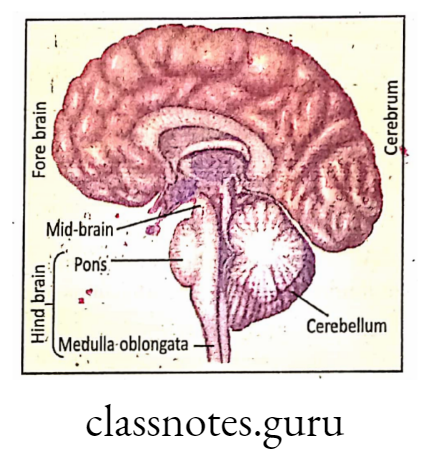
The average weight of an adult brain is about 1.36 kg. It is divided into three main parts e.g., forebrain, midbrain and hindbrain.
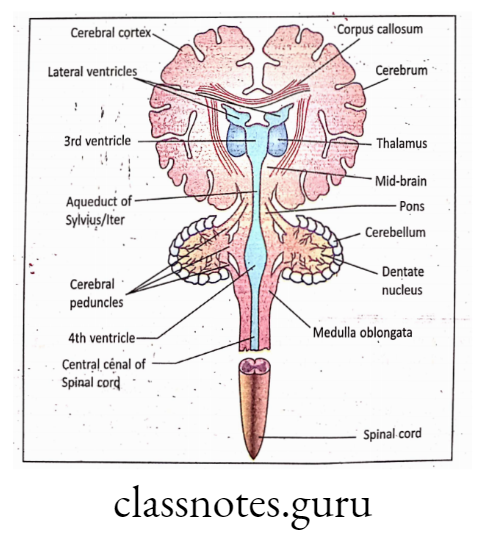
Components (different parts) of Brain :
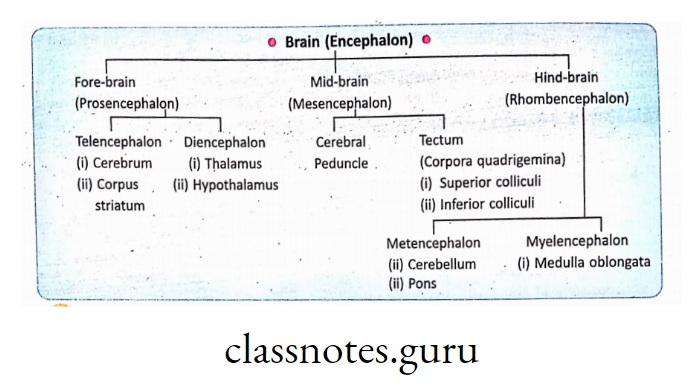
Fore-brain: The most anterior portion of the brain is called fore-brain. It consists of cerebrum, thalamus, hypothalamus, etc.
Cerebrum : (a) Location and Structure—Cerebrum Is the most superior region of CNS.
Cerebrum is the largest part of the human brain which occupies most of the portion (more than three-fourth) of the skull cavity. The total surface area of cerebrum is about 2200 sq.
cm. which is about three times more than the inner surface of the skull.
Cerebral cortex is the outer layer of cerebrum 2-3 mm thick, made up of six-layers of nerve cells. To accommodate a bigger thing in a smaller area, the cerebral cortex becomes folded upon itself producing furrows i.e., sulci (shallow grooves), fissures (deeper grooves) and convolutions, i.e., gyri (singgyrus).
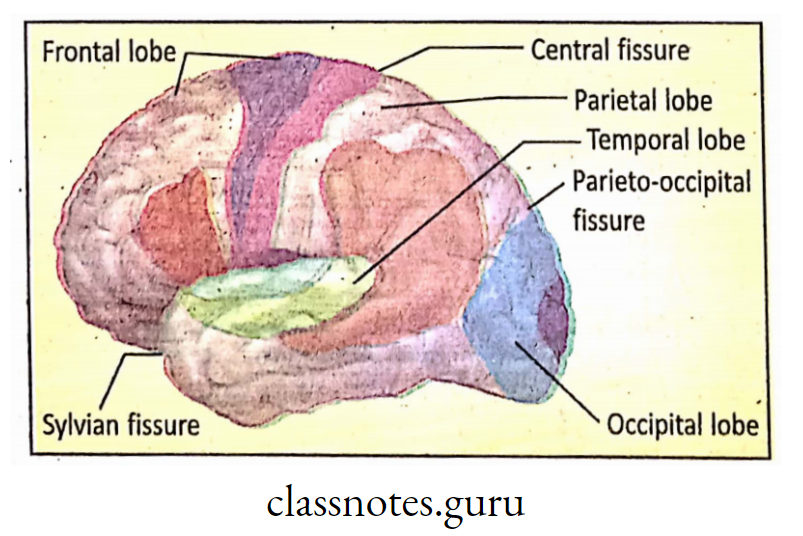
The outer part of cerebrum is made up of mainly cell bodies of neurones and branching dendrites called grey matter. Certain functional areas are found in the outer part (cortex) of the different lobes.
The inner part is mainly made up of nerve fibres (axons) called white matter (Grey matter is also written as Gray matter)
In brain, grey matter is present peripherally and white matter centrally whereas ] in spinal cord this orientation is just reverse.
Lobes of cerebrum—The cerebrum consists of two symmetrical hemispheres which are connected by a broad band of fibres called corpus callosum. Corpus callosum is exclusively found in mammalian brain.
Neocortex of cerebrum is the site of intelligence in man. Each hemisphere is divided into five lobes such as frontal lobe, parietal lobe, occipital lobe, temporal lobe and limbic lobe (area) by four main’ fissures (deep grooves).
Functions—
- Some parts of the cerebrum act as motor centres which control all types of voluntary movements of the muscles,
- Some parts act as sensory centres and thus receive and analyse the general sensation like pain, temperature,touch, etc.
- Frontal lobe acts as centre for memory, intelligence, judgement, etc.
- It is the seat of learning process (conditioned reflex),
- Different lobes of the cerebrum acts as important centres like speech, writing, vision, audition, taste, etc.
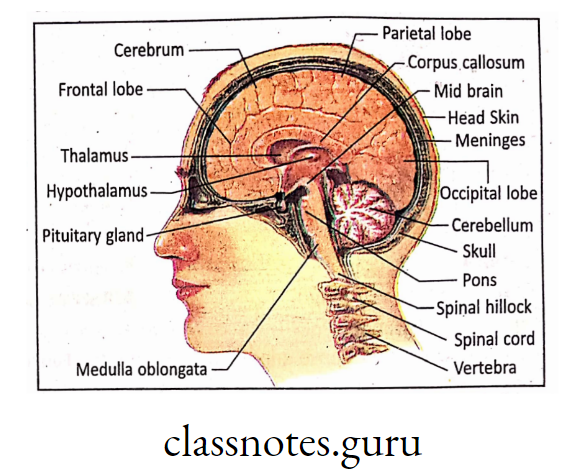
Thalamus: Location—Thalamus is the mass of grey matter (large collection of cell bodies) which is present at the base of the fore-brain and lateral to both side of the third ventricle (brain cavity).
Functions—
- Acts as a.relay station because it receives all afferent (sensory) fibres from all parts of the body and sends efferent (motor) fibres to the sensory areas of the cerebrum,
- It acts-as highest centre for all types of crude senses,
- Acts as important centre for emotion and reflex activities.
Hypothalamus: Location—The hypothalamus is the basal part of the fore-brain and forms the floor of third ventricle. It consists of groups of nuclei and fibres.
Functions—
- Hypothalamus acts as highest centre for autonomic nervous system,
- It regulates body temperature (thermoregulation),
- It controls the emotional behaviour, sexual behaviour of the animals,
- It acts as centres for feeding, thirst (osmoregulation), hunger, sleep, etc.
- It controls the secretory activity of the pituitary gland.
Mid-brain: Location—Mid-brain is the uppermost portion of the brain stem and connects the fore-brain with hind-brain. The part of mammalian brain consisting of. midbrain, Pons and Medulla oblongata is together called as brain stem.
It has two parts i.e., tectum and cerebral peduncle. Functions-Mid-brain serves as a centre for mediating visual, auditory and tactile (touch) impulses. Grossly brain stem means whole of the brain except cerebrum and cerebellum. All cranial nerves develop from brain stem.
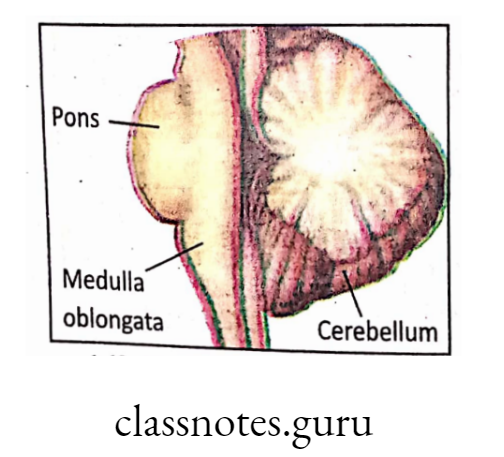
Hind-brain: The hind-brain is the lowermost part of the brain. It consists of mainly cerebellum, pons and medulla oblongata.
Cerebellum :
Location and Structure
Cerebellum is the largest part of the hind-brain which is situated behind the pons and medulla oblongata and under occipital lobe of the cerebrum. It consists of two hemispheres which are connected by a median portion caHed vermis. Each hemisphere contains many fissures
Functions—
- Cerebellum maintains muscle tone, equilibrium and body posture (postural balance),
- It regulates and co-ordinates the group of muscles during different activities like walking or running.
Difference between Cerebrum and Cerebellum :

Control and Co-ordination in Living Organisms: Nervous System and Hormones
Pons: Location—Pons is the convex white eminence of -the hind-brain. It is situated below mid-brain and above the medulla oblongata. Functions—Pons contains respiratory,cardiac and vasomotor centres. They regulate respiration, heart rate and blood pressure respectively.
Medulla obiongata: Location—Medulla oblongata is the conical expanded last part of the brain stem (hind-brain), which lies just above 4he-spinal cord.
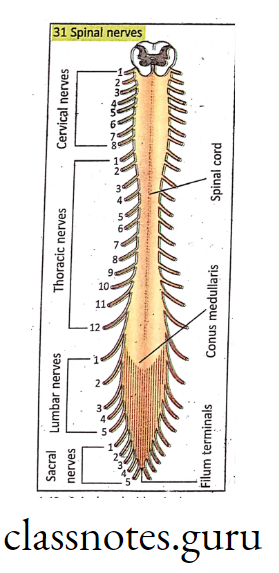
Functions—
- In Medulla,various centres are present which regulate the respiratory,vasomotor and cardiac activities,
- It controls the visceral reflexes.
Components and Functions of Spinal cord :
The cylindrical part of the central nervous system which is present within the vertebral canal and extends from the foramen magnum upto the first or second lumbar vertebra is called spinal cord.
Foramen Magnum is the opening present at the base of the skull through which spinal cord joins with the brain.
External structure: The spinal cord is about 45 cm long and 1.25 cm wide, cylindrical in shape. It rapidly narrows below the lumbar enlargement into cone shaped structure called conus rnedullaris.
From conus rnedullaris thread like non nervous filaments called filum terminals pass downwards.
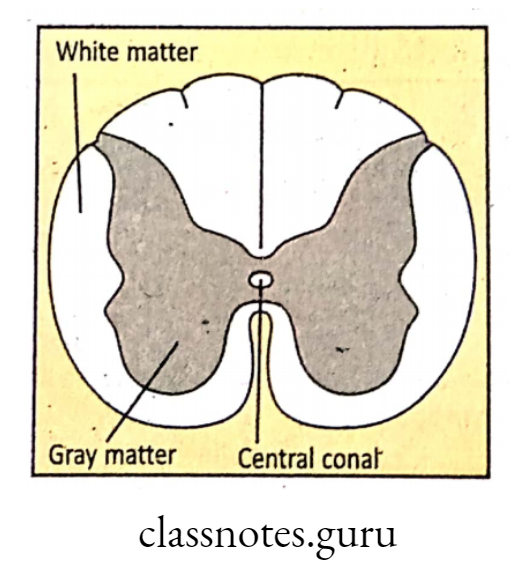
Conus rnedullaris and filum terminale together look like horse tail known as Cauda equina. Although the spinal cord is a continuous structure yet functionally it is divisible into 31 segments.
It consists of 8 cervical, 12 thoracic, 5 lumbar, 5 sacral and 1 coccygeal segments. From these 31 segments 31 pairs of spinal nerves originate.
Internal structure: Internally the spinal cord consists of centrally H -shaped grey matter and peripherally white matter. A tubular space filled up with CSF running through the centre of the grey matter of the spinal cord is called central canal.
Neurocoel central canal of spinal cord as well as ventricles of brain whereas spinocoel means the space inside spinal cord only.
Functions of Spinal cord :
- Spinal cord acts as centre for different reflexes.
- It acts as connecting organ as it connects the different parts of the body with brain.
- It acts as centre for autonomic nervous system. The sympathetic nerves originate from thoracic and lumbar regions and the parasympathetic from sacral region.
Location and function of Meninges and CSF:
Central Nervous System (CNS) is symmetrically divisible into two lateral halves, ft consists of brain and spinal cord.
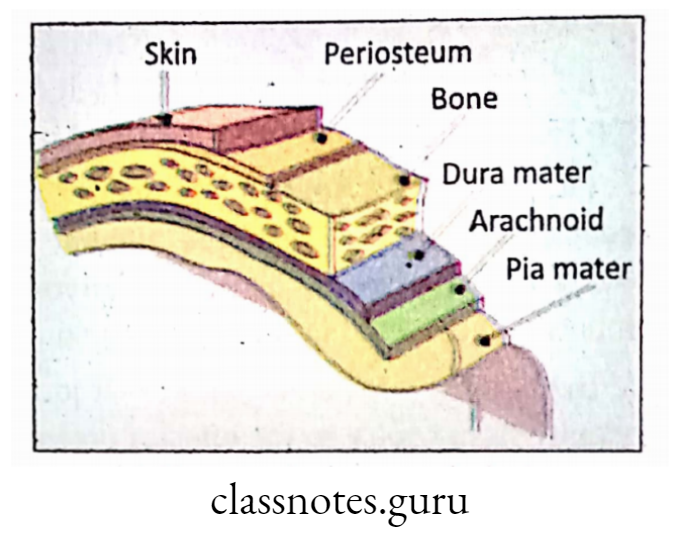
Meninges: The whole of the CNS (Brain and Spinal cord) is covered by soft, protective membranes called.’meninges. It* consists’ of three layers—outer Dura mater, middle Arachnoid and inner Pia mater
Function :
- They protect the brain and spinal cord from mechanical injury.
- They provide blood supply to the skull and to hemispheres.
- They also provide a space for the flow of cerebrospinal fluid.
Cerebrospinal Fluid (CSF): It is clear, colourless, transparent tissue fluid present in the ventricle of brain and central canal of spinal cord. CSF is formed in the choroid plexus of the brain.
Function :
- CSF acts as shock absorber for CNS. Thus it protects the brain and spinal cord against external injury.
- CSF circulates nutrients and 02 to cells of CNS. (Do you know glucose is the major nutrient of biÿain ?)
- CSF excretes waste products from brain and spinal cord.
Class 10 Science: Control and Co-ordination Notes
Reflex action with common examples :
Definition: Reflex action is spontaneous involuntary (autonomous) motor response due to sensory stimulus.

Common examples of reflex action:
- When light falls on the eyes, the eyelids close unconsciously.
- Immediate withdrawal of hand when it touches a hot object.
- When a sharp tap is given by a hammer to the patellar tendon, a sudden jerk (knee jerk) takes place.
Reflex arc and its components :
Definition: An arc like neural path through which reflex action takes place is called reflex arc. It consists of receptor, afferent nerve, centre (adjustor), efferent nerve and effector.
Components of reflex arc.: Reflex arc consists of five parts.
Receptor—It is a specialized sensory ending which is stimulated by the environmental changes.
Afferent or Sensory neurone—It forms afferent limbs of the reflex path. It conducts impulse from the receptor to the nerve centre.
Nerve Centre—The grey matter of the central nervous system, spinal cord or brain stem acts as centre. Here the afferent neurone makes synaptic connection with efferent neurone either directly or through internuncial neurones.
In the nerve centre, the sensory impulse is converted into the motor impulse (response).
Efferent or Motor neurone—It forms the efferent limbs of reflex path. It carries nerve impulse from centre to the effector organs.
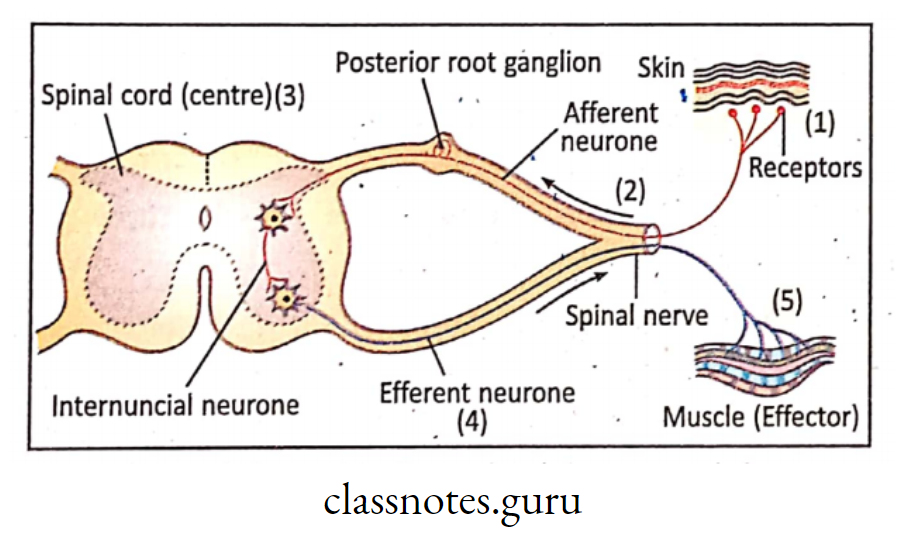
Effector organ or Effector—The muscle or gland where the motor neurone ends is called effector (muscles or glands).
It works according to the response (directives) of nerve centre, carried by efferent neurone.
Types of Reflexes : Two types—Unconditioned (Inborn) reflexes and Conditioned (Acquired) reflexes.
Unconditioned or Inborn reflexes :
Definition: The reflexes which are not acquired but present since the time of birth are called unconditioned reflexes.
Examples: Removal of fingertip from hot object; Knee jerk reflex; Closure of eyelid in bright light etc.
Conditioned or Acquired reflexes :
Definition: The reflexes acquired as a result of prolonged or repeated training or practice are called conditioned reflexes.
These reflexes are learned reflexes, because they arise during lifetime by careful and patient practices.
Examples :
Reading, writing, cycling,swimming, playing a musical instrument etc
The Russian physiologist Ivan Pavlov is well known for his experiment on conditioned reflexes.

Pavlov’s Experiment :
Pavlov used to give some food to a dog.Usually the dog salivated on eating the food. He used to sound a bell (training) that had nothing to do with salivation. But continued association of the sound of bell with the food caused salivation not only in response to food but also to the sound of bell.
So later on,when only the bell rang, without giving food, the dog salivated. This shows that the reflex of salivation to the sound was acquired by the dog as a result of repeated training or practice for a long time at a stretch.
Difference between Conditioned and Unconditioned reflexes :
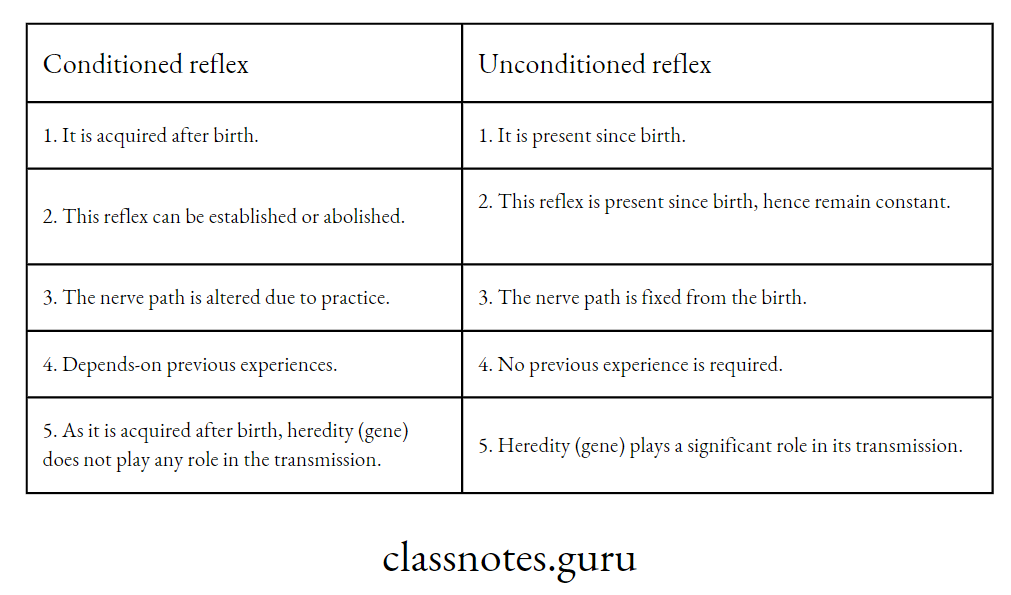
Importance of different reflexes in everyday life :
Blinking of eye: Eyelids are folds of skin, controlled by speedy movement of muscles. It can move very fast and does not disrupt our vision. This is called blinking of eye. Blinking keeps our eye moist.
The fluid is secreted from tear gland (Lacrymal gland). During blinking, the fluid spreads all over the eye. An enzyme, called lysozyme, is present in the tear that can kill bacteria.
Blinking also protects eyes against dust, dirt, sand etc. In fact, eyelash works like feather duster to protect eyeball against tiny particles.
Coughing: A sudden explosive forcing of air through glottis due to mechanical or chemical irritation of the trachea or bronchi is “called coughing. The- epithetttrrrr ofrespiratory tract is highly sensitive to both mechanical and chemical stimuli.
So little amount of dust or other foreign matter or secretion of excess mucus from inner wall of respiratory tract may cause irritation to initiate cough reflex.
Cough reflex removes foreign material and excess mucus from the respiratory tract and thus protects the lungs.
Cough reflex is constituted by :
- Afferent pathway—Sensofy hefve fibre ofvagus nerve (10th cranial nerve).
- Central pathway (cough.centre)—Central coordination for coughing is brain stem.
- Efferent pathway—Impulse,(res|3onse)’from cough centre moves through efferent nerves to diaphragm, abdominal muscles.
Sneezing: Due to irritation of mucus membrahe of nose, there may be sudden expulsion of blast of air through the nose and mouth by involuntary vigorous contraction of expiratory muscles known as sneezing.
Sneezing may occur due to sudden change intemperature, breeze ofcold air, viral infection and so on. The function of sneezing is tcÿexpel mucus (containing foreign particles orirritants) and thus to cleanse the nasal cavity.
Eye as a sense organ in human:
The environment, in which we live, influences our life. It is therefore essential for our bodies to sense any change in the environment in order to adjust with these changes.
By performing such changes and by communicating them to the central nervous system, the sense organs help to make a correct interpretation of the environment, so that the body make necessary adjustments.
The structures which are capable of detecting the presence of some specific type of agent in the environment and reacting to this agent by sending impulses through their afferent . nerves to the central nervous system are called sense organs.
The sense organs of man are of five types such as eye, ear, tongue, nose and skin. Out of these skin belongs to general sense organ where as eye, ear, tongue and nose belong to ‘special sense organs.
They are also known as skin (Tangoreceptor), Eye (Photoreceptor), Ear (Phonoreceptor), Tongue (Gustatoreceptor), Nose (Olfactoreceptor).
EYE—The organ of vision :
- The special sense organ consisting of photosensitive receptors, the rod cells and cone cells and helps to see the object is known as eye.
- Location: The two eyes are located in the deep cavities of the skull called orbits which are situated on the frontal side of the cranium. Two eye balls rest on the pad of fat in the-orbit.
Control and Co-ordination in Living Organisms: Class 10 Science Notes
Structure and Functions of eye :
Each eyeball is nearly spherical fluid filled ball and is approximately 2-5 cm in diameter. It consists-of the coats of the eye-ball, the refractory media and protective part of the eye-ball.
Function of eye :
- It helps to see the shape and size of the object.
- It also helps in perception of colour of the object.
- Eye estimates the approximate distance (location) of the object (depth perception).
- Human eye provides three dimensional image.
- Dim-light vision by rod cell;, bright light vision, colour differentiation and accuracy of vision by cone cells.
- It takes part in visual reflex.
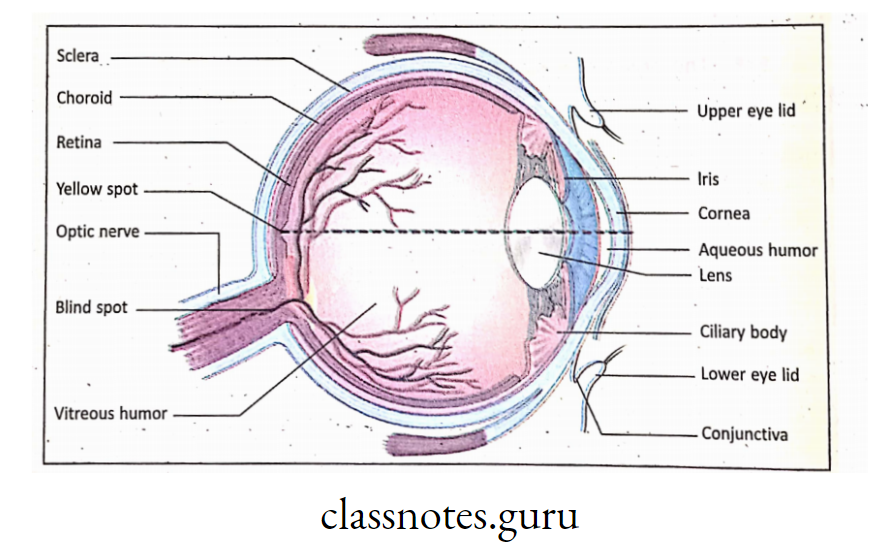
Chart showing the main parts of Eye :
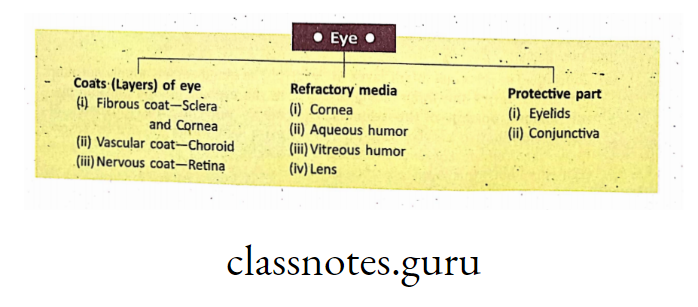
Difference between Retina and Cornea :
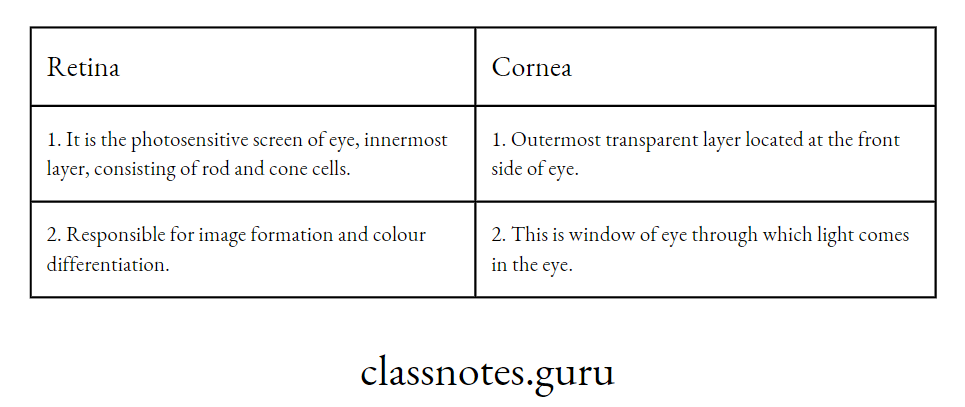
Difference between Rod cell and Cone cell :

Difference between Blind spot and Yellow spot :

Binocular vision in human and how it differs from monocular vision :
Definition: The phenomenon of seeing one object with two eyes is known as binocular vision So, it is vision using two eyes with overlapping fields of view, and good perception of depth.”
Binocular vision is found in dogs, cats, apes, humans, etc.
Advantages of binocular vision :
- Binocular vision helps to determine the distance between objects and their size.
- It provides three dimensional vision.
- It helps in depth perception (stereoscopic vision).
- The combined field of vision of two eyes is wider than that of single eye.
- It allows us to see an object even behind an obstacle
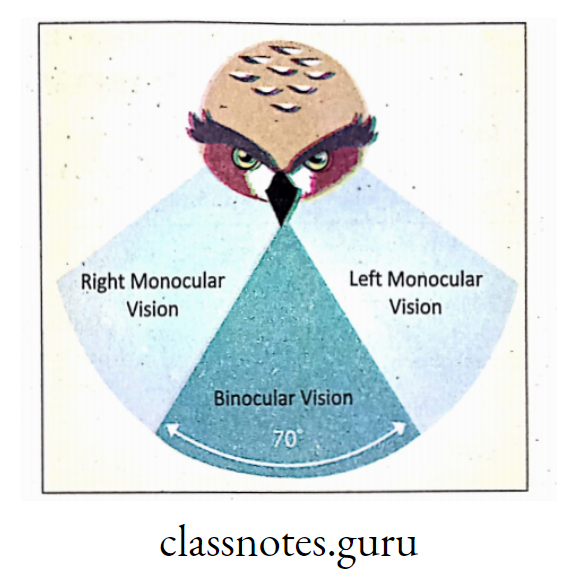
Monocular vision :
Definition: The vision in which the two eyes are used separately on two different field of vision simultaneously is called monocular vision.
Most fishes, most birds, lizards, horses,bats, rabbits have monocular vision. Here,the advantage is wide field of vision, which enables them to respond quickly to danger or other stimulus. But they have poor depth of perception.
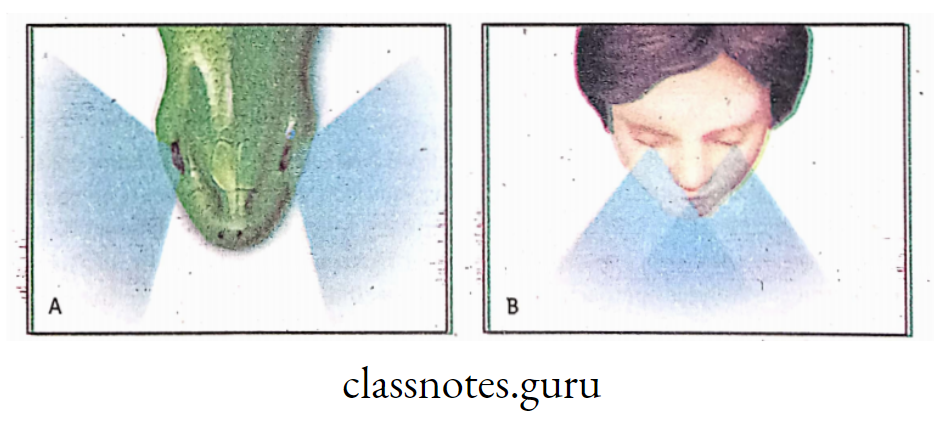
Difference between binocular and monocular vision :

Class 10 Science Chapter: Control and Co-ordination Review
Accommodation
Definition: Accommodation is the adjustment of eye for seeing objects at various distances. This is accomplished mainly by ciliary muscle which controls the focal adjustment of lens of the eye.
Thus the lens is flattened or. thickened for distant or near vision. So, accommodation is the ability of eye lens to adjust its focal length.
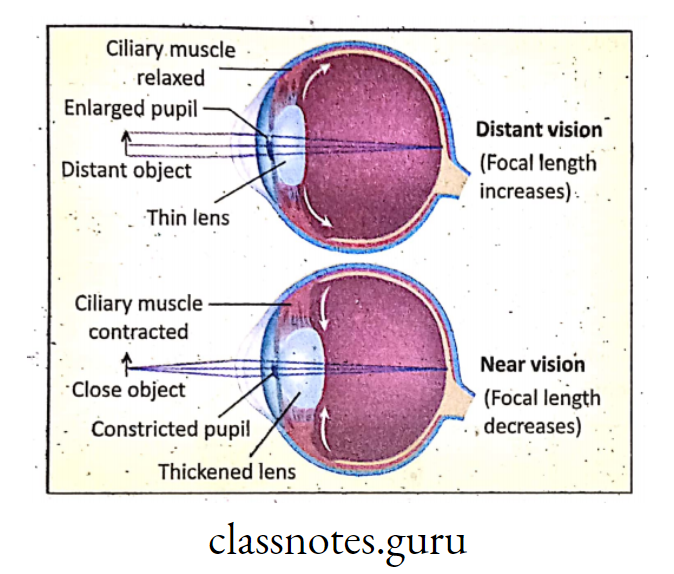
Role of accommodation in our daily life situation :
Example 1: A pedestrian is walking on the road. He looks at his wrist watch, then the road (any potholes), level of the road,then looking passersby, looking at top’ floor of a multistoried
.building, immediately after the far distant sky .and so on.
Thus there is frequent change of focal lengtJi of the eye, achieved by accommodation.
Example 2 : . A driver is moving with a car or any vehicle. He watches bumper (speed breaker), road directions, pedestrians, other passing vehicles etc. The driver must be very alert to notice all these by his eyes with continuous adjustment of focal length at different distances (accommodation of eye).
Suppose, he notices a red signal at about 50 metre distance and slows down the car. As he is approaching slowly towards the signal, the distance between the signal and car gradually decreases. Hence there is rapid accommodation of eye with variable focal length.
The eye adjusts the shape of lens to keep objects in focus :
Looking at distant objects (Distant vision) : (eg. Looking at a ship in deep sea, an . aeroplane high in sky etc.). The following events take place
Ciliary muscles are relaxed——–> lens becomes thin——-> Focal length of the lens increases——–> object at distant point is focussed and seen.
Lookin& at objects closer to eye (Near vision) : (eg. Reading a book, looking.at computer screen, watching time in wrist watch etc.) The following events occur
Ciliary muscles contract —————> Increase in curvature of eye lens ——————> Lens becomes thick—————-> Focal length of lens decreases————–> object at near place is focussed and seen clearly
Defects Of Vision And Corrective Measures :
Loss of Power of Accommodation—Myopia, Hyperopia and Presbyopia:
Myopia(Near sjghtedness/short sightgdpess) :
The Defect—In myopia, a person can see near objects clearly but fails to see distant objects. So they have normal near sightedness like reading books] computer use etc. But they have difficulty to see distant objects, signs etc.
The problem occurs when the eyeball becomes too long so that light rays focus at a point in front of the retina but not directly on the surface of retina.
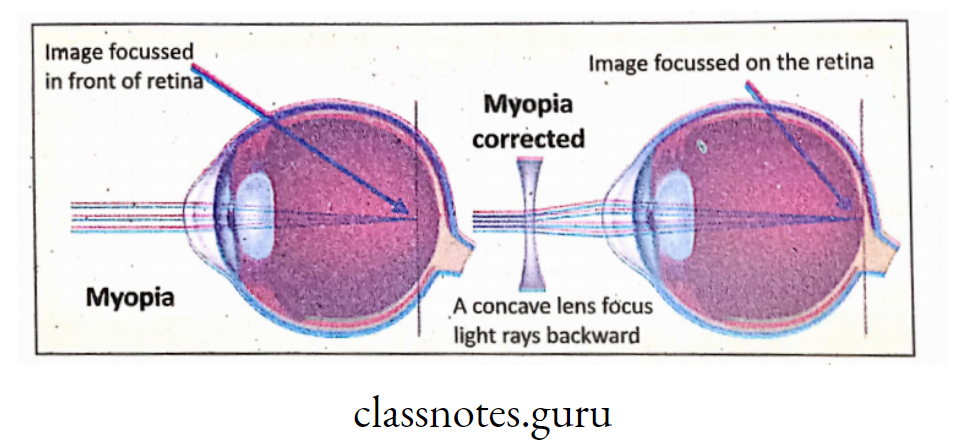
Corrective measure—The defect of myopia can be corrected by using biconcave lens in spectacle or contact lens [commonly known as minus (-) power]
Hyperopia (Hypermetropia / Farsightedness / Longsightedness) :
The Defect—ln hyperopia, the person can see distant objects very well but unable to see near objects clearly. They can not read books well neither can read computer screen correctly.
The problem occurs when the eyeball becomes shorter than normal. The light rays coming from distant object focus normally on retina but the light rays from near objects is focussed behind the retina forming a hazy (blurred image)..
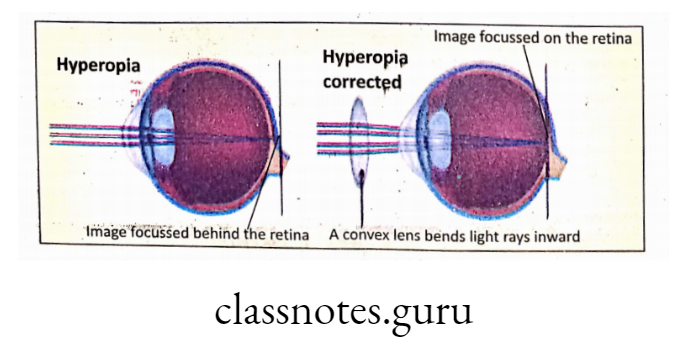
Corrective measure— The defect can be corrected by using biconvex lens in spectacle or contact lens [ commonly known as . plus (+) power].
Presbyopia :
The Defect— This is a defect of eye associated with aging (generally 40 years +) where a person fails to see details of nearby objects. The defect is primarily due to loss of elasticity of crystalline lens because of weak power of ciliary muscle as well as gradual thickening of lens.
This defect results into eye strain for reading books, computer study or to focus on near objects due to lack of proper accommo-dation of eye.
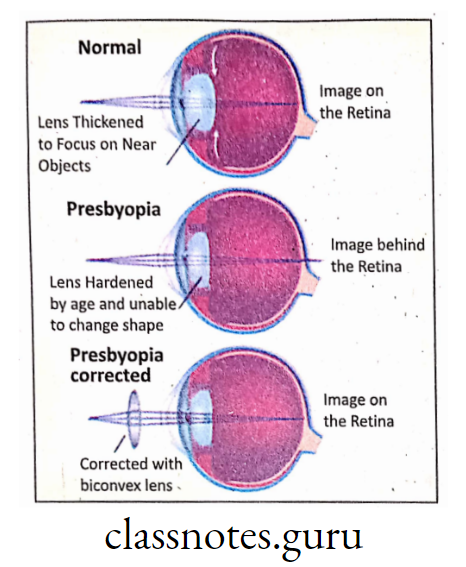
Corrective measure—Presbyopia can be corrected by using biconvex lens in spectacle.
Cataract :
The Defect— A cataract is clouding (opacity) of eye’s natural lens. This is the most common cause of loss of vision in people of age above 40 years. The lens is mostly made of water and protein. With advancement of age,some of the proteins may clump together making the lens opaque.
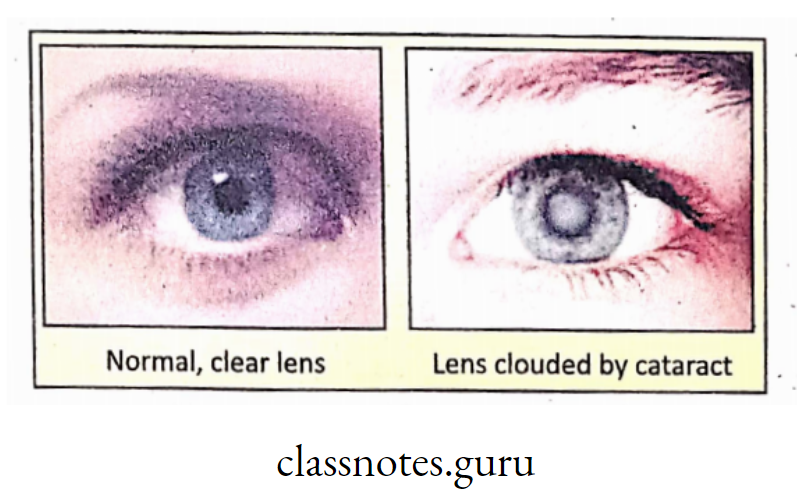
The common causes of cataract is aging, diabetes, obesity, smoking,consumption of alcohol etc.
Corrective measure—Cataract can be corrected by replacing the defective lens with an artificial lens (plastic intraocular lens—IOL). However, the modern cataract surgery is phacoemulsification or.in short Rbaco.
Locomotion as a type of response in animals
Locomotion :
The process by which the living organisms (mostly animals) can change the whole body from one place to other due to voluntary movement of their locomotory organs is known as locomotion.
The sensitivity of larger animals is evident in some common situations e.g. when they hunt for food, escape under attack, for breeding or reproduction at a particular season, in search of food and shelter and so on.
Animal responses are. usually quick movements which involve muscles, bones and joints.
For locomotion, movement of the locomotory organs is required. If we move our leg,we can locomote from one place to another. This is the relation between
locomotion.
Difference between movement and locomotion :
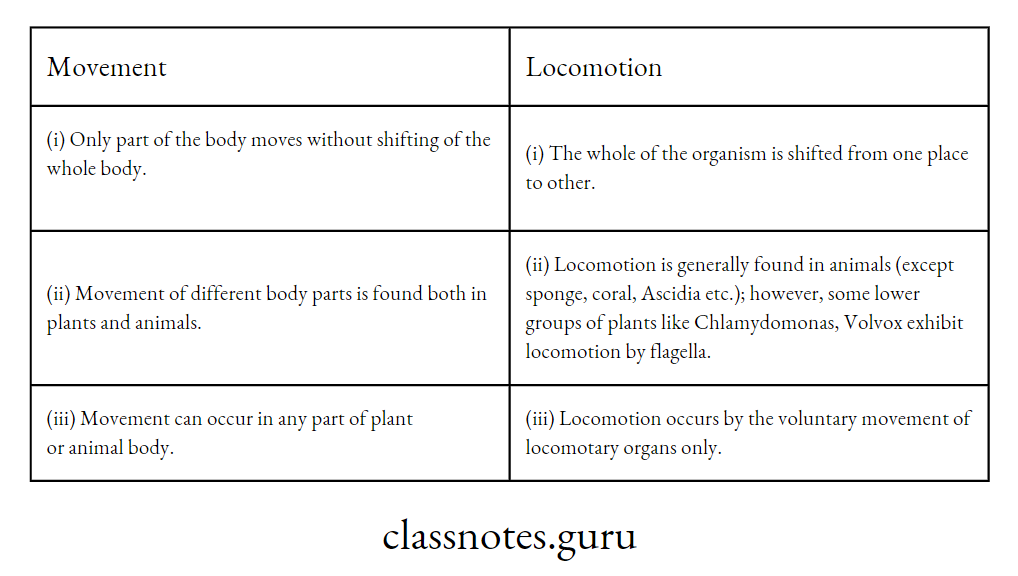
Motivation behind locomotion (Purpose of locomotion) :
The purpose of locomotion are many. There is a need of locomotion in order to maintain different functions df the animals. These purposes are stated below ;
To acquire food—Animals are not able to prepare their
search of food they have to move from one place to another. Also for drinking water the terrestrial aninrtdis are moving to water bodies.
Shelter—In order to live a normal life and to perform all the living functions properly,a suitable shelter is necessary for all animals. Thus, animals have to move from one place to another.
Avoiding capture by predators –Animals have undergo locomotion in order to protect Themslves from danger . Let suppose, atiger is chasing to a deer. The tiger is running after the deer in search of food whereas the deer is running away for protection—and thus to avoid capture”by predator (tiger)
Despersal —By locomotion, animals may be dispersed from a particular spot to different places. For example, the honey bees are dispersing from bee hive to various directions in search of nectar and pollen grain.
Search of new and favourable habitat/environment—Animals may locomote from one place to another place in search of new, favourable habitat. For example, some Siberian birds migrating from colder climate to less colder climate in winter.
This migration of birds is a good example of locomotion for favourable habitat.
Bringing together individuals for reproductive activity—Another significant necessity of locomotion is to perform reproductive activity. For example, Hilsa fish swims from saline water of sea to fresh water of river in order to lay eggs, fertilization by sperm and thus to perform reproduction.
Class 10 Science: Control and Co-ordination Key Concepts
Different types of animal locomotion :
Various methods of animal locomotion may be discussed as follows :
Amoeboid locomotion involving pseudopodia—Amoeba shows amoeboid locomotion with its locomotory organ pseudo-podia or false foot. Pseudopedia are finger-like temporary projections on any part of the surface of body.

In the amoeba, there is denser peripheral plasmagel or ectoplasm whereas in the inner part of the body. there is less denser central plasmasol or endoplasm.
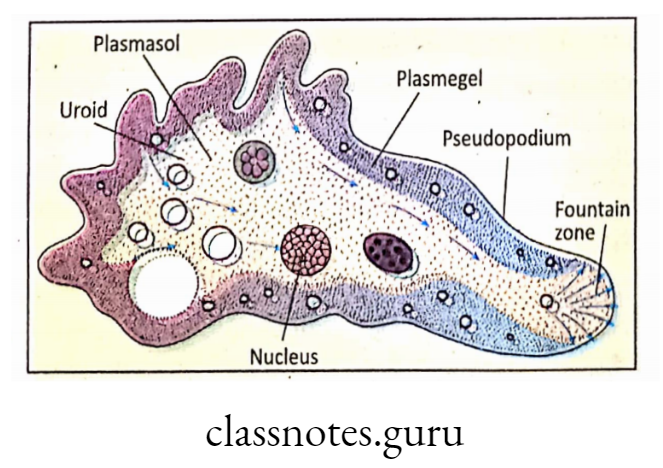
Plasmagel (gel) is denser (due to presence of more proteins) than plasmasol (sol). During formation of pseudopodia, plasmagel is converted to plasmasol and moves forward to form pseudopodia. This is known as sol-gel transformation.
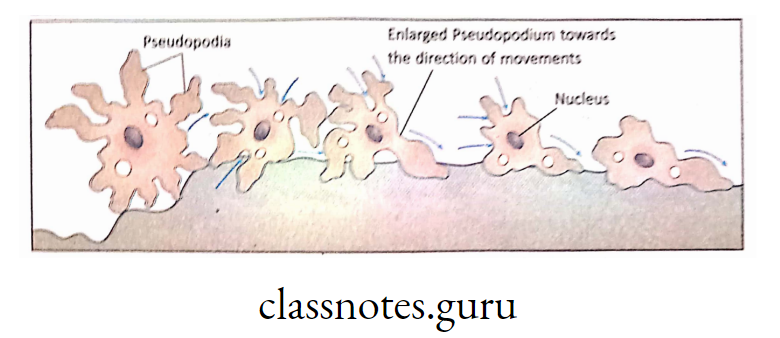
WBC also exhibits; amoeboid movement by pseudopodia formation.
Ciliary locomotion in Paramoecium — Pararnoecium is unicellular aquatic protozoa, which is provided v/ith fine hair-like protoplasmic processes called cilia. The cilia is attached v/ith basal granule in the body.
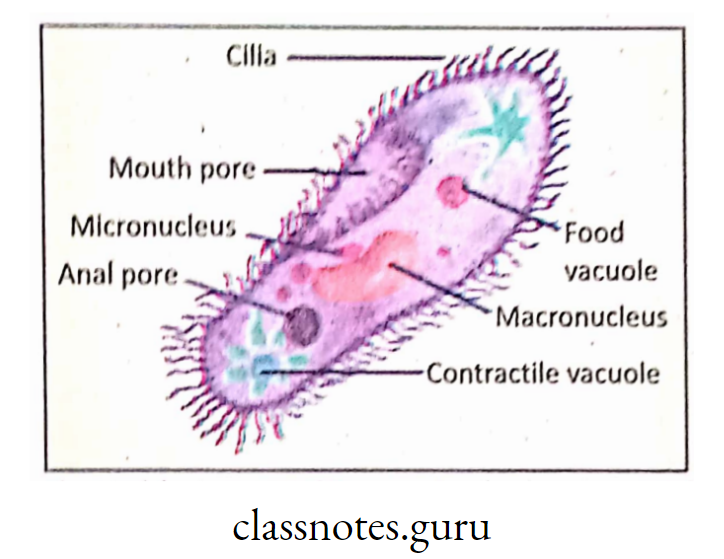
Paramoecium moves v/ith the synchronous beating of cilia.

Flagellar locomotion in Euglena- Euglena is unicellular aquatic protista. The body is green in colour due to presence of chloroplast. Euglena contains one pair of fiageiln—one long and another short.
Fhgoila is whip-like structure connected with the body by basal granule. Euglena can swim from one place to other with beating of flagella.

Swimming in fish—
Muscles of fish: V-shaped muscles of fish called myotome muscles are arranged segmentally in each side of the flexible vertebral column. Contraction and relaxation of the myotome muscles on each side causes lateral undulation and propulsion of the body.
When the muscles of left side contract, those of right side will relax, and the body will bend on the left side. When muscles contract in the opposite side, the body bends towards the right side and lashing of tail takes place
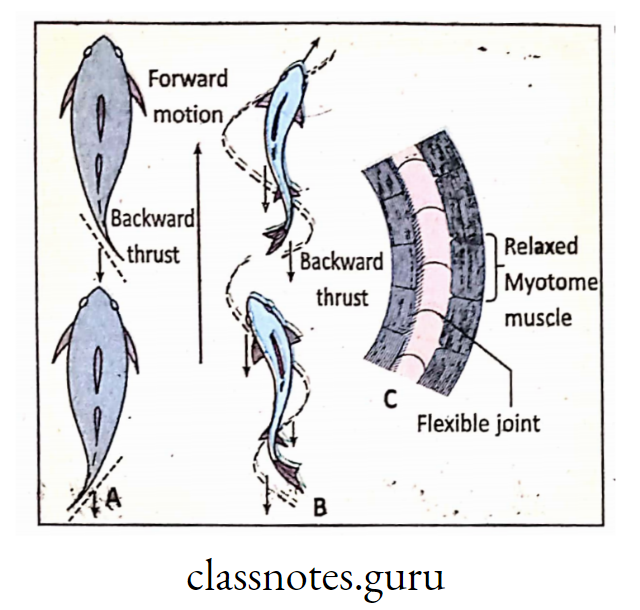
Fins of fish: fins are the appendages on the body of fishes. The fins are membranous extension of the skin and are supported by fin rays. There are altogether seven fins present in each fish. Two are paired and three are unpaired fins.
The paired fins are—
- Pectoral fins—attached behind the opercula, and
- Pelvic fins_attached to the ventral side.
The unpaired fins are—
- caudal fin or tail fin located at the end of the tail,
- anal fin located at the mid ventral side and
- dorsal fin located at the mid dorsal line.

Functions—Fins help to maintain stability and direction of movements of the fish.
- Pectoral and pelvic fins help animals in keeping the body in horizontal position,
- Dorsal fin facilitates anterior movement,
- The tail fin acts as steering apparatus for change of direction,
- The anal fin maintains the vertical positioin of fish.
Flight in bird (e.g. Pigeon)—Three important organs are necessary for flight in birds— wings, feathers and flight muscles.
Wings—Forelimbs of birds are modified into wings. wings are complex structures consisting of bones, muscles, nerve, blood vessels and feathers. ,
Function—During flight the wings are expanded and flapped by the action of flight muscles. In resting condition, the wings are folded on the body.
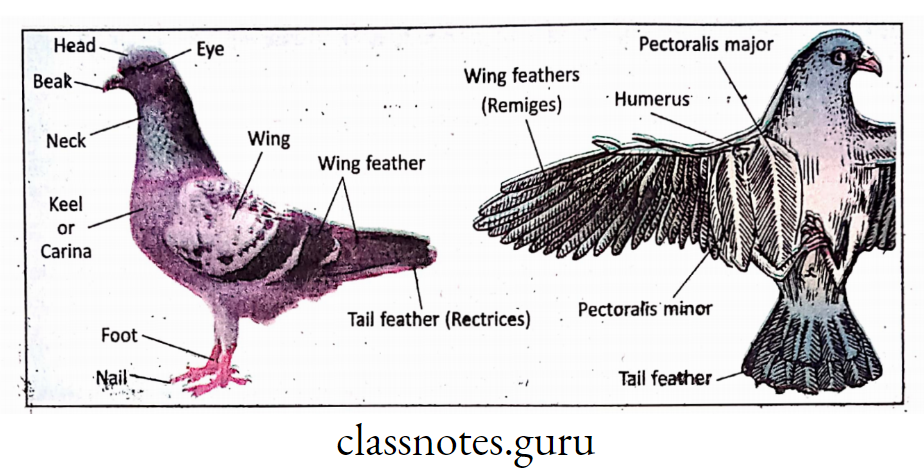
Feathers—They are leaf structures consisting of vane, barb and barbules. Feathers on bird are of different shape and size. The big size feathers on the wings are called Remiges and the big feathers on the ta‘i are called Rectrices.
Remiges help in flapping while rectrices help in steering during flight.
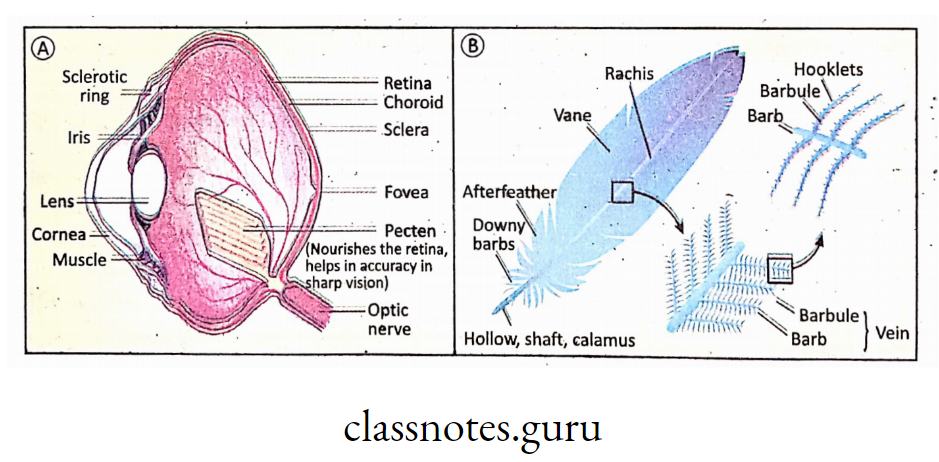
Function—
- Feathers greatly increase the surface area of wings and thus help in flight.
- They help to maintain body temperature thermoregulation).
- Moreover, feathers also act as waterproof coat.
Flight muscles Some important muscles in the body of bird are very strong for flapping, the wings known as flight muscle :
- Pectoralis major-helps in downstroke of wing;
- Pectoralis minor—helps in elevating wing;
- Coracobrachialis—helps in depressing wing.
You should know the running bird like Ostrich is called RATITAE and the flying bird is called CARINATAE.
Locomotion in human— Walking is the commonest form of human locomotion. The process of walking takes place with the help of two legs by the alternate contraction and
relaxation of muscles, movement of synovial (movable) joints etc. Since the locomotion in man takes place by alternate movement of two legs, hence it is called bipedal locomotion.
The process of bipedal locomotion in man is completed in three steps—propulsion,support and balance.

Mechanism of Control and Co-ordination in Plants and Animals
Stages of bipedal locomotion :
- During walking, one leg always rests on the ground which support the body weight (support) and the other leg moves (propulsion).
- In the moving leg, the heel is first raised from the ground, then the toes, then the whole leg moves forward and placed on the ground again (propulsion).
- After the forward movement, the heel of the moving leg touches the ground first, then the toes come down. Similar movement then occurs in the other leg.
- The contraction of the calf muscle (Gastrocnemius) helps in gripping the sole on the ground.
- The alternate movement of both the legs thereby help in locomotion.
- During walking, there is alternate swinging of the arm—i.e. right arm with left leg and left arm with right leg. This process helps to maintain balance between right and left side of the body.
- Cerebellum of brain controls postural balance during locomotion. Internal ear of man also plays a very significant role of body balance during walk.
Role of movable joints and skeletal muscles In human locomotion :
Locomotion in man is accomplished by the proper functioning of three kinds of tissues as follows :
- Bones and their joints
- Skeletal muscle
- Tendon and ligament.
Bones: These are composed of living osteoblast cells with high concentration of calcium and other mineral salts. Bones form endoskeleton that forms the internal framework of the body with internal support. You should know there are 206 bones in man.
Joints: These are junctional points where two or more bones join. There are three principal patterns of bone joints viz.
- Immovable joints where the bones are firmly joined together e.g. joint of the skull bones.
- Semimovable joints where the joint allows little flexible movement

e.g. joint between adjacent vertebrae of vertebral column.
Movable joints or Synovial joint where the joint allows free movement of bones in different direction. There is a cavity known as synovial cavity filled up with synovial fluid that acts as lubricant The whole cavity is lined by synovial membrane.

The bones are interconnected by ligament. At the tip of each bone there is a soft cartilage to prevent friction between two bones.
Important movable joints are ball and socket joint and Hinge joint.
Ball and Socket joint: This type of joint is formed when a rounded head (Ball) of one bone fits into cup shaped socket of another, e.g.
Head of humerus (upper arm) fits into glenoid cavity of pectoral girdle (shoulder girdle) commonly called as shoulder joint; head of femur (upper leg or thigh bone) fits into acetabulum cavity of pelvic girdle (Hip girdle)—commonly called as hip joint.
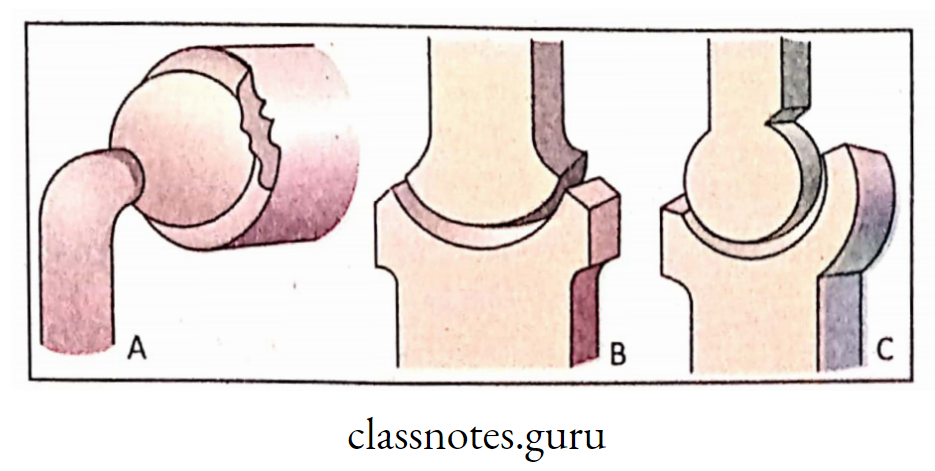
This joint allows 360’ move-ment in different axis.
Hinge joint: |n tÿjs j0jnt move like the hinge of a door in one plane only.

e.g. Elbow joint, knee joint. This joint allows 180′ movement in one axis only.
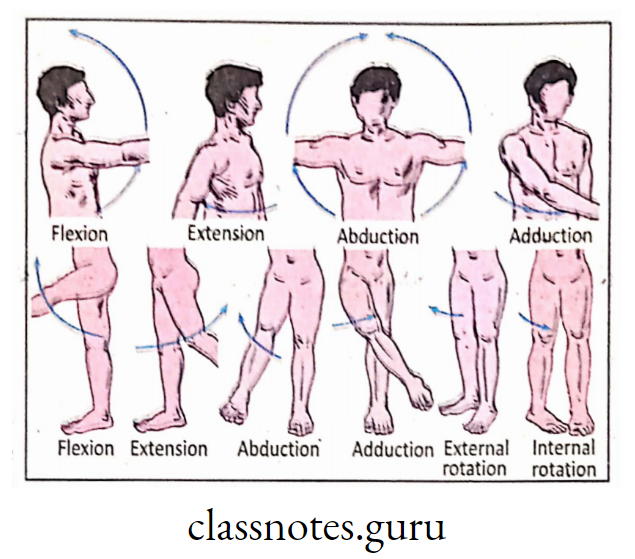
Following types of movements of joints are observed, that are operated by various skeletal muscles attached to the bonesjoints.
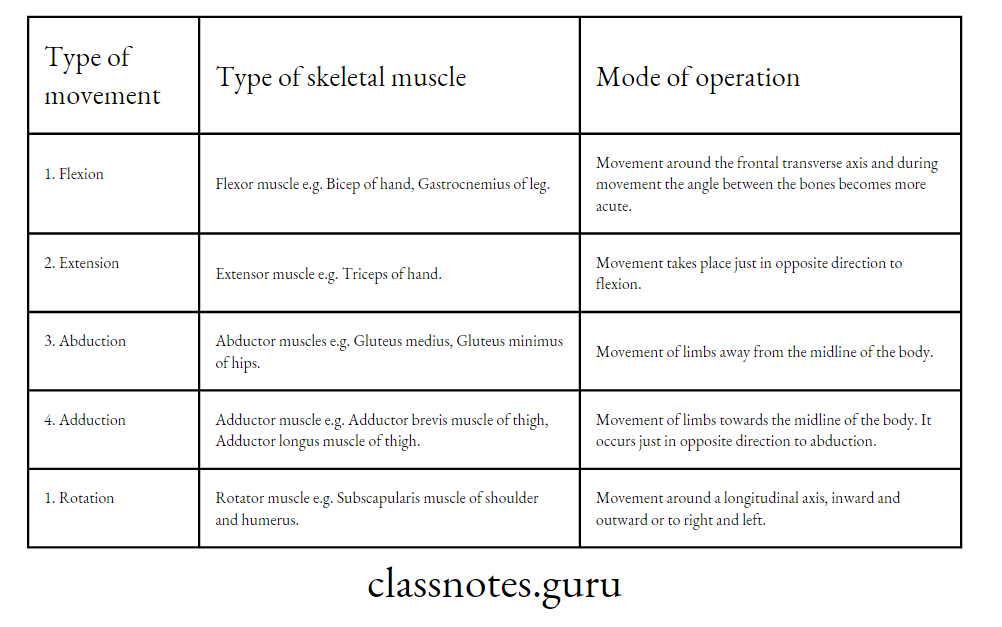
There are approximately 640 skeletal.muscles in human body.
